Proposing Optimal Locations for Runoff Harvesting and Water Management Structures in the Hami Qeshan Watershed, Iraq
Abstract
1. Introduction
2. Materials and Methods
2.1. Study Area
2.2. Conceptual Methodology
2.3. Data Acquisition
2.4. Statistical Model
2.4.1. Weighted Linear Combination (WLC)
2.4.2. Analytic Hierarchy Process (AHP)
2.5. Evaluative Criteria
2.5.1. Geological Criteria
2.5.2. Topographic Criteria
2.5.3. Hydrologic/Meteorologic Criteria
2.5.4. Environmental Criteria
2.5.5. Socioeconomic Criteria
2.6. Model Validation
3. Results
3.1. Generation of Runoff Harvesting Suitability Maps
3.2. Validation of the WLC and AHP Models
3.3. Identification of New Sites for Dam Construction
4. Discussion
5. Conclusions
Author Contributions
Funding
Data Availability Statement
Acknowledgments
Conflicts of Interest
Appendix A
| Criterion | Sub-Criterion | Class | RH Suitability | WLC | |
|---|---|---|---|---|---|
| Criterion Weight% | Normalized Weight | ||||
| Lithology | River | 1 | US | 13 | 0.537 |
| FP | 1 | US | 0.537 | ||
| AF | 1 | US | 0.537 | ||
| RBU | 3 | MS | 1.611 | ||
| RBL | 3 | MS | 1.611 | ||
| NWG | 4 | HS | 2.148 | ||
| SH | 2 | LS | 1.074 | ||
| ABT | 5 | ES | 2.685 | ||
| KRG | 5 | ES | 2.685 | ||
| SPG | 5 | ES | 2.685 | ||
| QR | 5 | ES | 2.685 | ||
| QC | 3 | MS | 1.611 | ||
| PC | 5 | ES | 2.685 | ||
| GG | 5 | ES | 2.685 | ||
| BK | 4 | HS | 2.148 | ||
| SG | 5 | ES | 2.685 | ||
| MG | 5 | ES | 2.685 | ||
| JU | 5 | ES | 2.685 | ||
| UJ | 5 | ES | 2.685 | ||
| DL | 5 | ES | 2.685 | ||
| −113 to −50 | 5 | ES | 3.356 | ||
| −50 to −25 | 4 | HS | 2.685 | ||
| TPI | −25 to −10 | 3 | MS | 16 | 2.013 |
| −10 to 0 | 2 | LS | 1.342 | ||
| 0 to 116 | 1 | US | 0.671 | ||
| 0–3 | 5 | ES | 2.685 | ||
| 3–8 | 4 | HS | 2.148 | ||
| Slope (degree) | 8–15 | 3 | MS | 13 | 1.611 |
| 15–30 | 2 | LS | 1.074 | ||
| >30 | 1 | US | 0.537 | ||
| <605 | 1 | US | 0.403 | ||
| 605–625 | 2 | LS | 0.805 | ||
| Precipitation (mm/yr.) | 625–650 | 3 | MS | 10 | 1.208 |
| 650–675 | 4 | HS | 1.611 | ||
| >675 | 5 | ES | 2.013 | ||
| <1 | 1 | US | 0.671 | ||
| 1–5 | 2 | LS | 1.342 | ||
| Stream Width (m) | 5–10 | 3 | MS | 16 | 2.013 |
| 10–30 | 4 | HS | 2.685 | ||
| >30 | 5 | ES | 3.356 | ||
| Leptosols | 1 | US | 0.403 | ||
| Soil Group | Calcisols | 3 | MS | 10 | 0.805 |
| Vertisols B | 4 | HS | 1.611 | ||
| Vertisols A | 5 | ES | 2.013 | ||
| 632–900 | 5 | ES | 2.013 | ||
| 900–1100 | 4 | HS | 1.611 | ||
| Elevation (m) | 1100–1300 | 3 | MS | 10 | 1.208 |
| 1300–1500 | 2 | LS | 0.805 | ||
| >1500 | 1 | US | 0.403 | ||
| Built-up Land | 1 | US | 0.268 | ||
| Cropland and Pasture | 3 | MS | 0.805 | ||
| Cultivated Land | 3 | MS | 0.805 | ||
| Harvested Land | 3 | MS | 0.805 | ||
| Land Cover | Mixed Barren Land | 3 | MS | 6 | 0.805 |
| Natural Vegetation | 3 | MS | 0.805 | ||
| Clastic Rocks | 3 | MS | 0.805 | ||
| Burned Land | 3 | MS | 0.805 | ||
| Carbonate Rocks | 5 | ES | 1.342 | ||
| Igneous/Metamorphic Rocks | 5 | ES | 1.342 | ||
| 0–1770 | 1 | US | 0.134 | ||
| 1770–4460 | 2 | LS | 0.268 | ||
| Distance to Faults (m) | 4460–8140 | 3 | MS | 3 | 0.403 |
| 8140–12,110 | 4 | HS | 0.537 | ||
| >12,110 | 5 | ES | 0.671 | ||
| 0–250 | 1 | US | 0.134 | ||
| 250–2500 | 5 | ES | 0.671 | ||
| Distance to Town/City | 2500–5000 | 4 | HS | 3 | 0.537 |
| 5000–10,000 | 3 | MS | 0.403 | ||
| 10,000–15,000 | 2 | LS | 0.268 | ||
| >15,000 | 1 | US | 0.134 | ||
| Criterion | Sub-Criterion | Rank | RH Suitability | AHP | |
|---|---|---|---|---|---|
| Criterion Weight% | Normalized Weight | ||||
| River | 1 | US | 0.015 | ||
| FP | 1 | US | 0.015 | ||
| AF | 1 | US | 0.015 | ||
| RBU | 5 | MS | 0.074 | ||
| RBL | 5 | MS | 0.074 | ||
| NWG | 7 | HS | 0.104 | ||
| SH | 3 | LS | 0.044 | ||
| ABT | 9 | ES | 0.133 | ||
| KRG | 9 | ES | 0.133 | ||
| Lithology | SPG | 9 | ES | 13 | 0.133 |
| QR | 9 | ES | 0.133 | ||
| QC | 5 | MS | 0.074 | ||
| PC | 9 | ES | 0.133 | ||
| GG | 9 | ES | 0.133 | ||
| BK | 7 | HS | 0.104 | ||
| SG | 9 | ES | 0.133 | ||
| MG | 9 | ES | 0.133 | ||
| JU | 9 | ES | 0.133 | ||
| UJ | 9 | ES | 0.133 | ||
| DL | 9 | ES | 0.133 | ||
| −113 to −50 | 9 | ES | 0.190 | ||
| −50 to −25 | 7 | HS | 0.148 | ||
| TPI | −25 to −10 | 5 | MS | 19 | 0.106 |
| −10 to 0 | 3 | LS | 0.063 | ||
| 0 to 116 | 1 | US | 0.021 | ||
| 0–3 | 9 | ES | 0.133 | ||
| 3–8 | 7 | HS | 0.104 | ||
| Slope (degree) | 8–15 | 5 | MS | 13 | 0.074 |
| 15–30 | 3 | LS | 0.044 | ||
| >30 | 1 | US | 0.015 | ||
| <1 | 1 | US | 0.021 | ||
| 1–5 | 3 | LS | 0.063 | ||
| Stream Width (m) | 5–10 | 5 | MS | 19 | 0.106 |
| 10–30 | 7 | HS | 0.148 | ||
| >30 | 9 | ES | 0.190 | ||
| <605 | 1 | US | 0.010 | ||
| 605–625 | 3 | LS | 0.029 | ||
| Precipitation (mm/yr.) | 625–650 | 5 | MS | 9 | 0.048 |
| 650–675 | 7 | HS | 0.068 | ||
| >675 | 9 | ES | 0.087 | ||
| Soil Group | Leptosols | 1 | US | 9 | 0.010 |
| Calcisols | 5 | MS | 0.048 | ||
| Vertisols B | 7 | HS | 0.068 | ||
| Vertisols A | 9 | ES | 0.087 | ||
| 632–900 | 9 | ES | 0.087 | ||
| 900–1100 | 7 | HS | 0.068 | ||
| Elevation (m) | 1100–1300 | 5 | MS | 9 | 0.048 |
| 1300–1500 | 3 | LS | 0.029 | ||
| >1500 | 1 | US | 0.010 | ||
| Built-up Land | 1 | US | 0.006 | ||
| Cropland and Pasture | 5 | MS | 0.031 | ||
| Cultivated Land | 5 | MS | 0.031 | ||
| Harvested Land | 5 | MS | 0.031 | ||
| Land Cover | Mixed barren Land | 5 | MS | 5 | 0.031 |
| Natural Vegetation | 5 | MS | 0.031 | ||
| Clastic Rocks | 5 | MS | 0.031 | ||
| Burned Land | 5 | MS | 0.031 | ||
| Carbonate Rocks | 9 | ES | 0.055 | ||
| Igneous/Metamorphic Rocks | 9 | ES | 0.055 | ||
| 0–1770 | 1 | US | 0.002 | ||
| 1770–4460 | 3 | LS | 0.006 | ||
| Distance to Faults (m) | 4460–8140 | 5 | MS | 2 | 0.010 |
| 8140–12,110 | 7 | HS | 0.014 | ||
| >12,110 | 9 | ES | 0.019 | ||
| 0–250 | 1 | US | 0.002 | ||
| 250–2500 | 9 | ES | 0.019 | ||
| Distance to Town/City | 2500–5000 | 7 | HS | 2 | 0.014 |
| 5000–10,000 | 5 | MS | 0.010 | ||
| 10,000–15,000 | 3 | LS | 0.006 | ||
| >15,000 | 1 | US | 0.002 | ||
| Site | River Order | Latitude | Longitude | Main Purpose | Dam Height | Storage Capacity | Catchment |
|---|---|---|---|---|---|---|---|
| No. | (m) | (Million m3) | Area (km2) | ||||
| 1 | Qala Chulan 2 | 35.5736 | 45.9236 | Irrigation, Energy | 30 | 8 | 178.4 |
| 2 | Qala Chulan 2 | 35.6830 | 45.6534 | Irrigation, Energy | 25 | 1.45 | 313.6 |
| 3 | Unk 4 | 35.7241 | 45.9424 | Irrigation | 17 | 2 | 8.8 |
| 4 | Siway 3 | 35.7555 | 45.7240 | Irrigation, Energy | 50 | 40 | 1152.3 |
| 5 | Siway 3 | 35.7500 | 45.6667 | Irrigation, Energy | 43 | 29 | 1202.5 |
| 6 | Siway 3 | 35.7667 | 45.5350 | Energy | 50 | 40 | 1480.7 |
| 7 | Siway 3 | 35.7634 | 45.5081 | Irrigation, Energy | 23 | 11 | 1509.9 |
| 8 | Qala Chulan 2 | 35.7595 | 45.4284 | Irrigation, Energy | 56 | 300 | 2425.8 |
| 9 | Unk 4 | 35.8037 | 45.3094 | Irrigation | 20 | 2 | 23.4 |
| 10 | Capelon 3 | 35.7903 | 45.3806 | Irrigation | 28 | 6 | 152.3 |
| 11 | Qala Chulan 2 | 35.8097 | 45.4280 | Irrigation, Energy | 12 | 11 | 2642 |
| 12 | Mawat 3 | 35.8615 | 45.4756 | Irrigation | 44 | 2 | 48 |
| 13 | Mawat 3 | 35.7925 | 45.4648 | Irrigation, Energy | 39 | 3 | 104.3 |
| 14 | Mawat 3 | 35.8085 | 45.4430 | Energy | 75 | 18 | 114.3 |
| 15 | Qala Chulan 2 | 35.8679 | 45.3983 | Energy | 29 | 50 | 2828.3 |
| 16 | Qala Chulan 2 | 35.9661 | 45.3974 | Energy | 34 | 10 | 2875.7 |
| Buffer | Method-Scenario | Suitability Measure | MAWR Dam Site | |||||||||||||||
|---|---|---|---|---|---|---|---|---|---|---|---|---|---|---|---|---|---|---|
| 1 | 2 | 3 | 4 | 5 | 6 | 7 | 8 | 9 | 10 | 11 | 12 | 13 | 14 | 15 | 16 | |||
| 1000 m | TP | 3487 | 3488 | 3488 | 3487 | 3488 | 3487 | 3490 | 3488 | 3490 | 3488 | 3487 | 3487 | 3487 | 3488 | 3487 | 1896 | |
| NP | 1948 | 3084 | 1584 | 3487 | 3004 | 3487 | 3144 | 3108 | 205 | 534 | 3197 | 834 | 1700 | 3147 | 3402 | 1884 | ||
| AHP | APn | 55.86 | 88.42 | 45.41 | 100 | 86.12 | 100 | 90.09 | 89.11 | 5.87 | 15.31 | 91.68 | 23.92 | 48.75 | 90.22 | 97.56 | 99.37 | |
| APw | 52.29 | 63.68 | 47.40 | 64.73 | 62.93 | 64.26 | 58.94 | 61.89 | 37.01 | 42.20 | 64.74 | 45.50 | 49.77 | 64.50 | 69.06 | 73.00 | ||
| OA | 54.08 | 76.05 | 46.41 | 82.37 | 74.53 | 82.13 | 74.51 | 75.50 | 21.44 | 28.75 | 78.21 | 34.71 | 49.26 | 77.36 | 83.31 | 86.18 | ||
| TP | 3487 | 3487 | 3487 | 3487 | 3487 | 3488 | 3487 | 3487 | 3488 | 3488 | 3488 | 3488 | 3487 | 3487 | 3487 | 1896 | ||
| NP | 1948 | 3179 | 1820 | 3487 | 3130 | 3488 | 3336 | 3121 | 283 | 858 | 3208 | 974 | 1989 | 3308 | 3419 | 1893 | ||
| WLC | APn | 55.86 | 91.17 | 52.19 | 100 | 89.76 | 100 | 95.67 | 89.50 | 8.11 | 24.60 | 91.97 | 27.92 | 57.04 | 94.87 | 98.05 | 99.84 | |
| APw | 52.36 | 64.81 | 49.74 | 65.73 | 64.28 | 65.21 | 59.84 | 62.89 | 38.67 | 44.03 | 65.15 | 47.66 | 51.45 | 65.04 | 69.84 | 73.82 | ||
| OA | 54.11 | 77.99 | 50.97 | 82.87 | 77.02 | 82.60 | 77.76 | 76.20 | 23.39 | 34.31 | 78.56 | 37.79 | 54.25 | 79.95 | 83.95 | 86.83 | ||
| 500 m | TP | 873 | 873 | 873 | 873 | 873 | 873 | 873 | 873 | 873 | 873 | 873 | 873 | 873 | 873 | 873 | 626 | |
| NP | 518 | 725 | 702 | 873 | 873 | 873 | 768 | 760 | 81 | 133 | 781 | 282 | 556 | 780 | 851 | 626 | ||
| AHP | APn | 59.34 | 83.05 | 80.41 | 100 | 100 | 100 | 87.97 | 87.06 | 9.28 | 15.23 | 89.46 | 32.30 | 63.69 | 89.35 | 97.48 | 100 | |
| APw | 52.85 | 61.45 | 55.64 | 64.91 | 66.43 | 64.78 | 59.77 | 63.11 | 39.46 | 42.26 | 65.66 | 46.86 | 51.77 | 64.09 | 71.62 | 73.43 | ||
| OA | 56.09 | 72.25 | 68.03 | 82.45 | 83.21 | 82.39 | 73.87 | 75.08 | 24.37 | 28.75 | 77.56 | 39.58 | 57.73 | 76.72 | 84.55 | 86.71 | ||
| TP | 873 | 873 | 873 | 873 | 873 | 873 | 873 | 873 | 873 | 873 | 873 | 873 | 873 | 873 | 873 | 626 | ||
| NP | 518 | 759 | 736 | 873 | 873 | 873 | 843 | 768 | 106 | 205 | 784 | 310 | 631 | 858 | 851 | 626 | ||
| WLC | APn | 59.34 | 86.94 | 84.31 | 100 | 100 | 100 | 96.56 | 88.07 | 12.16 | 23.48 | 89.81 | 35.51 | 72.28 | 98.28 | 97.48 | 100 | |
| APw | 52.94 | 62.51 | 58.14 | 65.84 | 67.47 | 65.73 | 60.67 | 64.19 | 41.19 | 44.00 | 66.05 | 49.02 | 53.50 | 64.62 | 72.23 | 74.16 | ||
| OA | 56.14 | 74.72 | 71.22 | 82.92 | 83.74 | 82.87 | 78.62 | 76.13 | 26.67 | 33.74 | 77.93 | 42.26 | 62.89 | 81.45 | 84.86 | 87.08 | ||
| 250 m | TP | 218 | 218 | 218 | 218 | 218 | 218 | 218 | 218 | 218 | 219 | 219 | 220 | 218 | 218 | 218 | 197 | |
| NP | 161 | 186 | 215 | 218 | 218 | 218 | 208 | 186 | 41 | 47 | 218 | 80 | 149 | 183 | 208 | 197 | ||
| AHP | APn | 73.85 | 85.32 | 98.62 | 100 | 100 | 100 | 95.41 | 85.32 | 18.81 | 21.46 | 99.54 | 36.36 | 68.35 | 83.94 | 95.41 | 100 | |
| APw | 54.98 | 62.74 | 61.03 | 66.64 | 65.50 | 65.49 | 62.44 | 59.66 | 41.87 | 44.10 | 73.22 | 47.01 | 52.37 | 59.13 | 72.27 | 71.87 | ||
| OA | 64.42 | 74.03 | 79.83 | 83.32 | 82.75 | 82.74 | 78.93 | 72.49 | 30.34 | 32.78 | 86.38 | 41.69 | 60.36 | 71.54 | 83.84 | 85.93 | ||
| TP | 218 | 218 | 218 | 218 | 218 | 218 | 218 | 218 | 219 | 218 | 218 | 218 | 218 | 218 | 218 | 197 | ||
| NP | 161 | 190 | 218 | 218 | 218 | 218 | 214 | 186 | 44 | 57 | 217 | 85 | 150 | 217 | 208 | 197 | ||
| WLC | APn | 73.85 | 87.16 | 100 | 100 | 100 | 100 | 98.17 | 85.32 | 20.09 | 26.15 | 99.54 | 38.99 | 68.81 | 99.54 | 95.41 | 100 | |
| APw | 55.06 | 63.63 | 63.50 | 67.51 | 66.53 | 66.42 | 63.33 | 60.71 | 43.60 | 45.85 | 73.65 | 49.25 | 54.05 | 59.45 | 72.79 | 72.55 | ||
| OA | 64.46 | 75.39 | 81.75 | 83.76 | 83.27 | 83.21 | 80.75 | 73.02 | 31.85 | 36.00 | 86.60 | 44.12 | 61.43 | 79.49 | 84.10 | 86.28 | ||
| Mean | OA (AHP) | 58.20 | 74.11 | 64.76 | 82.71 | 80.16 | 82.42 | 75.77 | 74.36 | 25.38 | 30.09 | 80.72 | 38.66 | 55.78 | 75.21 | 83.90 | 86.28 | |
| OA (WLC) | 58.23 | 76.04 | 67.98 | 83.18 | 81.34 | 82.89 | 79.04 | 75.12 | 27.30 | 34.68 | 81.03 | 41.39 | 59.52 | 80.30 | 84.30 | 86.73 | ||
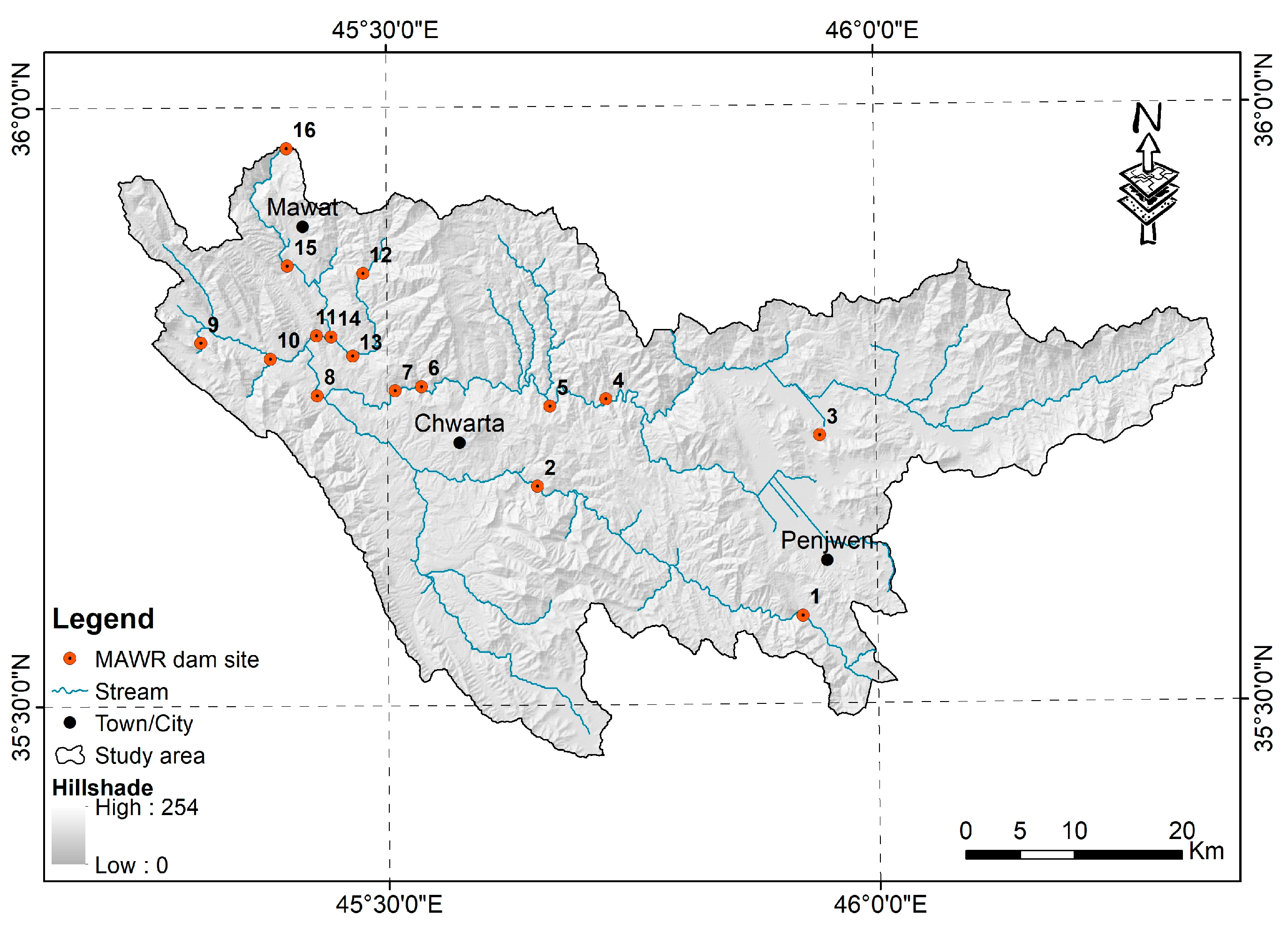
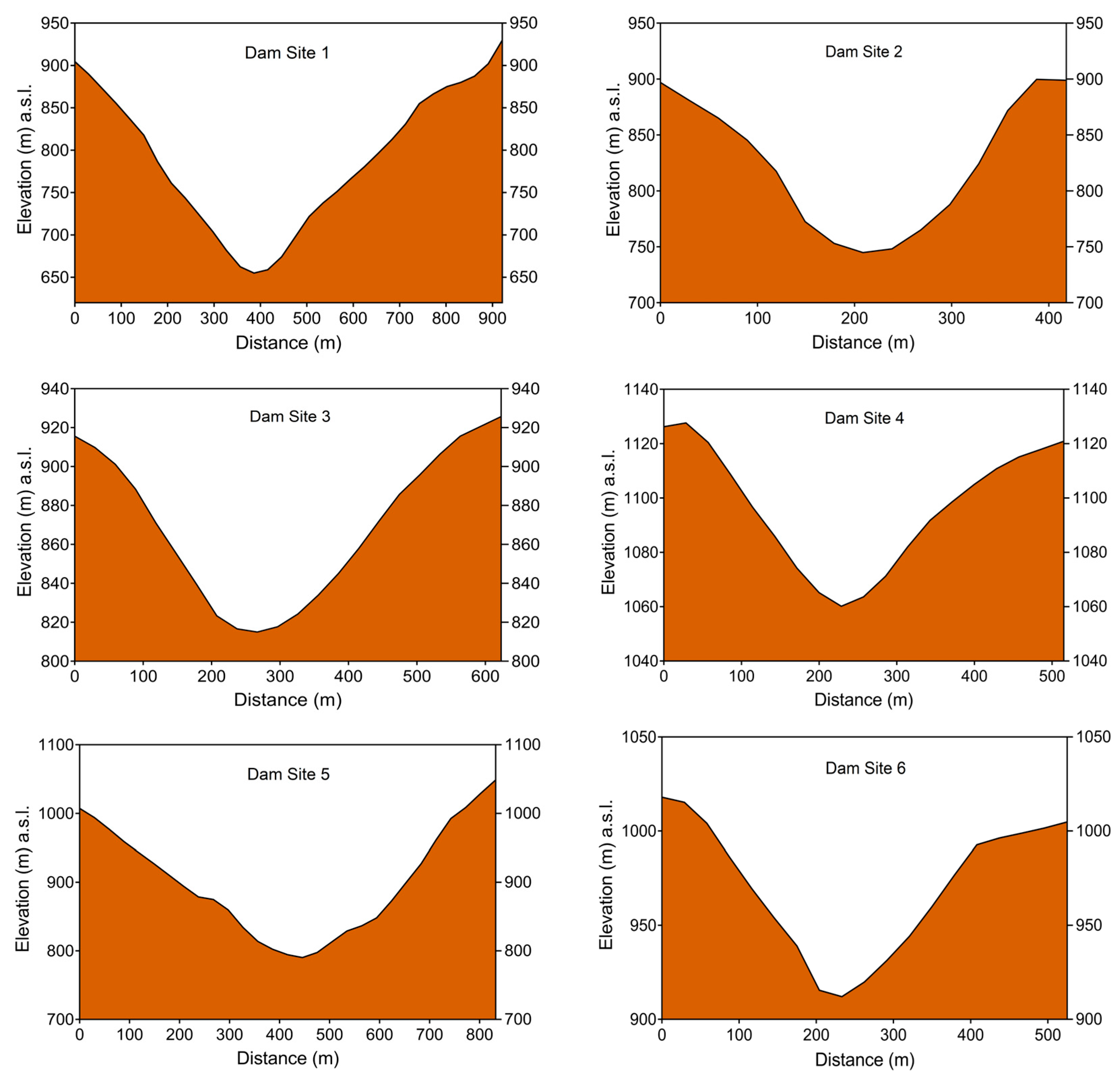

References
- Al-Muqdadi, S.W.; Omer, M.F.; Abo, R.; Naghshineh, A. Dispute over Water Resource Management-Iraq and Turkey. J. Environ. Prot. 2016, 7, 1096–1103. [Google Scholar] [CrossRef]
- Ibrahim, G.R.F.; Rasul, A.; Hamid, A.A.; Ali, Z.F.; Dewana, A.A. Suitable Site Selection for Rainwater Harvesting and Storage Case Study Using Dohuk Governorate. Water 2019, 11, 864. [Google Scholar] [CrossRef]
- CityPopulation. Available online: http://www.citypopulation.de/Iraq-Cities.html (accessed on 28 December 2022).
- Othman, A.A.; Al-Maamar, A.F.; Al-Manmi, D.A.M.A.; Liesenberg, V.; Hasan, S.E.; Obaid, A.K.; Al-Quraishi, A.M.F. GIS-Based Modeling for Selection of Dam Sites in the Kurdistan Region, Iraq. ISPRS Int. J. Geo Inf. 2020, 9, 244. [Google Scholar] [CrossRef]
- Rezaei, P.; Rezaie, K.; Nazari-Shirkouhi, S.; Tajabadi, M.R.J. Application of Fuzzy Multi-Criteria Decision Making Analysis for Evaluating and Selecting the Best Location for Construction of Underground Dam. Acta Polytech. Hung. 2013, 10, 187–205. [Google Scholar]
- Al-Muqdadi, S.W.H. Developing Strategy for Water Conflict Management and Transformation at Euphrates–Tigris Basin. Water 2019, 11, 2037. [Google Scholar] [CrossRef]
- Abbas, N.; Wasimi, S.A.; Al-Ansari, N.; Baby, S.N. Recent Trends and Long-Range Forecasts of Water Resources of Northeast Iraq and Climate Change Adaptation Measures. Water 2018, 10, 1562. [Google Scholar] [CrossRef]
- Umugwaneza, A.; Chen, X.; Liu, T.; Mind’je, R.; Uwineza, A.; Kayumba, P.M.; Uwamahoro, S.; Umuhoza, J.; Gasirabo, A.; Maniraho, A.P. Integrating a GIS-Based Approach and a SWAT Model to Identify Potential Suitable Sites for Rainwater Harvesting in Rwanda. AQUA Water Infrast. Ecosyst. Soc. 2022, 71, 415–432. [Google Scholar] [CrossRef]
- Rincón, D.; Khan, U.; Armenakis, C. Flood Risk Mapping Using GIS and Multi-Criteria Analysis: A Greater Toronto Area Case Study. Geosciences 2018, 8, 275. [Google Scholar] [CrossRef]
- Gaznayee, H.A.A.; Al-Quraishi, A.M.F.; Mahdi, K.; Messina, J.P.; Zaki, S.H.; Razvanchy, H.A.S.; Hakzi, K.; Huebner, L.; Ababakr, S.H.; Riksen, M.; et al. Drought Severity and Frequency Analysis Aided by Spectral and Meteorological Indices in the Kurdistan Region of Iraq. Water 2022, 14, 3024. [Google Scholar] [CrossRef]
- Adham, A.; Sayl, K.N.; Abed, R.; Abdeladhim, M.A.; Wesseling, J.G.; Riksen, M.; Fleskens, L.; Karim, U.; Ritsema, C.J. A GIS-Based Approach for Identifying Potential Sites for Harvesting Rainwater in the Western Desert of Iraq. Int. Soil Water Conserv. Res. 2018, 6, 297–304. [Google Scholar] [CrossRef]
- Alem, F.; Abebe, B.A.; Degu, A.M.; Goitom, H.; Grum, B. Assessment of Water Harvesting Potential Sites Using GIS-Based MCA and a Hydrological Model: Case of Werie Catchment, Northern Ethiopia. Sustain. Water Resour. Manag. 2022, 8, 70. [Google Scholar] [CrossRef]
- Güven, A.; Aydemir, A. Risk Assessment of Dams, 1st ed.; Springer Nature: Cham, Switzerland, 2020; p. 89. [Google Scholar]
- Chen, Y.; Li, J.; Jiao, J.; Wang, N.; Bai, L.; Chen, T.; Zhao, C.; Zhang, Z.; Xu, Q.; Han, J. Modeling the Impacts of Fully-Filled Check Dams on Flood Processes Using CAESAR-Lisflood Model in the Shejiagou Catchment of the Loess Plateau, China. J. Hydrol. Reg. Stud. 2023, 45, 101290. [Google Scholar] [CrossRef]
- Al-Kakey, O.H.; Othman, A.A.; Merkel, B.J. Identifying Potential Sites for Artificial Groundwater Recharge Using GIS and AHP Techniques: A Case Study of Erbil Basin, Iraq. Kuwait J. Sci. 2023, 50, 1–22. [Google Scholar] [CrossRef]
- Munir, B.A.; Ahmad, S.R.; Rehan, R. Torrential Flood Water Management: Rainwater Harvesting through Relation Based Dam Suitability Analysis and Quantification of Erosion Potential. ISPRS Int. J. Geo Inf. 2021, 10, 27. [Google Scholar] [CrossRef]
- Mullo-Sinaluisa, A.; Oquendo-Borbor, C.; Velastegui-Montoya, A.; Merchan-Sanmartín, B.; Chávez-Moncayo, M.; Herrera-Matamoros, V.; Carrión-Mero, P. Hill Dam Design to Improve Water Use in Rural Areas—Case Study: Sacachún, Santa Elena. Sustainability 2022, 14, 12268. [Google Scholar] [CrossRef]
- Amarandei, C.; Negru, A.-G.; Soroaga, L.-V.; Cucu-Man, S.-M.; Olariu, R.-I.; Arsene, C. Assessment of Surface Water Quality in the Podu Iloaiei Dam Lake (North-Eastern Romania): Potential Implications for Aquaculture Activities in the Area. Water 2021, 13, 2395. [Google Scholar] [CrossRef]
- Nowak, B.; Andrzejak, A.; Filipiak, G.; Ptak, M.; Sojka, M. Assessment of the Impact of Flow Changes and Water Management Rules in the Dam Reservoir on Energy Generation at the Jeziorsko Hydropower Plant. Energies 2022, 15, 7695. [Google Scholar] [CrossRef]
- Aghaloo, K.; Chiu, Y.-R. Identifying Optimal Sites for a Rainwater-Harvesting Agricultural Scheme in Iran Using the Best-Worst Method and Fuzzy Logic in a GIS-Based Decision Support System. Water 2020, 12, 1913. [Google Scholar] [CrossRef]
- Ion, I.V.; Ene, A. Evaluation of Greenhouse Gas Emissions from Reservoirs: A Review. Sustainability 2021, 13, 11621. [Google Scholar] [CrossRef]
- Sinthumule, N.I. Window of Economic Opportunity or Door of Exclusion? Nandoni Dam and Its Local Communities. Sustainability 2021, 13, 2502. [Google Scholar] [CrossRef]
- Jozaghi, A.; Alizadeh, B.; Hatami, M.; Flood, I.; Khorrami, M.; Khodaei, N.; Ghasemi Tousi, E. A Comparative Study of the AHP and TOPSIS Techniques for Dam Site Selection Using GIS: A Case Study of Sistan and Baluchestan Province, Iran. Geosciences 2018, 8, 494. [Google Scholar] [CrossRef]
- Milillo, P.; Bürgmann, R.; Lundgren, P.; Salzer, J.; Perissin, D.; Fielding, E.; Biondi, F.; Milillo, G. Space Geodetic Monitoring of Engineered Structures: The Ongoing Destabilization of the Mosul Dam, Iraq. Sci. Rep. 2016, 6, 37408. [Google Scholar] [CrossRef]
- Dykes, A.P.; Bromhead, E.N. The Vaiont Landslide: Re-Assessment of the Evidence Leads to Rejection of the Consensus. Landslides 2018, 15, 1815–1832. [Google Scholar] [CrossRef]
- Grebby, S.; Sowter, A.; Gluyas, J.; Toll, D.; Gee, D.; Athab, A.; Girindran, R. Advanced Analysis of Satellite Data Reveals Ground Deformation Precursors to the Brumadinho Tailings Dam Collapse. Commun. Earth Environ. 2021, 2, 2. [Google Scholar] [CrossRef]
- Othman, A.A.; Al-Maamar, A.F.; Al-Manmi, D.A.M.; Liesenberg, V.; Hasan, S.E.; Al-Saady, Y.I.; Shihab, A.T.; Khwedim, K. Application of DInSAR-PSI Technology for Deformation Monitoring of the Mosul Dam, Iraq. Remote Sens. 2019, 11, 2632. [Google Scholar] [CrossRef]
- Wang, Y.; Tian, Y.; Cao, Y. Dam Siting: A Review. Water 2021, 13, 2080. [Google Scholar] [CrossRef]
- Al-Ruzouq, R.; Shanableh, A.; Yilmaz, A.G.; Idris, A.; Mukherjee, S.; Khalil, M.A.; Gibril, M.B. Dam Site Suitability Mapping and Analysis Using an Integrated GIS and Machine Learning Approach. Water 2019, 11, 1880. [Google Scholar] [CrossRef]
- Al-Abadi, A.M.; Shahid, S.; Ghalib, H.B.; Handhal, A.M. A GIS-Based Integrated Fuzzy Logic and Analytic Hierarchy Process Model for Assessing Water-Harvesting Zones in Northeastern Maysan Governorate, Iraq. Arab. J. Sci. Eng. 2017, 42, 2487–2499. [Google Scholar] [CrossRef]
- Noori, A.M.; Pradhan, B.; Ajaj, Q.M. Dam Site Suitability Assessment at the Greater Zab River in Northern Iraq Using Remote Sensing Data and GIS. J. Hydrol. 2019, 574, 964–979. [Google Scholar] [CrossRef]
- Tiwari, K.; Goyal, R.; Sarkar, A. GIS-Based Methodology for Identification of Suitable Locations for Rainwater Harvesting Structures. Water Resour. Manag. 2018, 32, 1811–1825. [Google Scholar] [CrossRef]
- Shao, Z.; Jahangir, Z.; Muhammad Yasir, Q.; Atta-ur-Rahman; Mahmood, S. Identification of Potential Sites for a Multi-Purpose Dam Using a Dam Suitability Stream Model. Water 2020, 12, 3249. [Google Scholar] [CrossRef]
- Dube, T.; Shekede, M.D.; Massari, C. Remote Sensing for Water Resources and Environmental Management. Remote Sens. 2023, 15, 18. [Google Scholar] [CrossRef]
- Bajjali, W. ArcGIS for Environmental and Water Issues; Springer Nature: Cham, Switzerland, 2018; p. 363. [Google Scholar]
- Tong, D.; Murray, A.T. Spatial Optimization in Geography. Ann. Assoc. Am. Geogr. 2012, 102, 1290–1309. [Google Scholar] [CrossRef]
- Murray, A.T.; Xu, J.; Wang, Z.; Church, R.L. Commercial GIS Location Analytics: Capabilities and Performance. Int. J. Geogr. Inf. Sci. 2019, 33, 1106–1130. [Google Scholar] [CrossRef]
- Drobne, S.; Lisec, A. Multi-Attribute Decision Analysis in GIS: Weighted Linear Combination and Ordered Weighted Averaging. Informatica 2009, 33, 459–474. [Google Scholar]
- Saaty, T.L. How to Make a Decision: The Analytic Hierarchy Process. Eur. J. Oper. Res. 1990, 48, 9–26. [Google Scholar] [CrossRef]
- Yıldırım, Ü. Identification of Groundwater Potential Zones Using GIS and Multi-Criteria Decision-Making Techniques: A Case Study Upper Coruh River Basin (NE Turkey). ISPRS Int. J. Geo Inf. 2021, 10, 396. [Google Scholar] [CrossRef]
- Kouli, M.; Loupasakis, C.; Soupios, P.; Rozos, D.; Vallianatos, F. Landslide susceptibility mapping by comparing the WLC and WofE multi-criteria methods in the West Crete Island, Greece. Environ. Earth Sci. 2014, 72, 5197–5219. [Google Scholar] [CrossRef]
- Bashir, B.; Alsalman, A.; Othman, A.A.; Obaid, A.K.; Bashir, H. New Approach to Selecting Civil Defense Centers in Al-Riyadh City (KSA) Based on Multi-Criteria Decision Analysis and GIS. Land 2021, 10, 1108. [Google Scholar] [CrossRef]
- Othman, A.A.; Obaid, A.K.; Al-Manmi, D.A.M.; Pirouei, M.; Salar, S.G.; Liesenberg, V.; Al-Maamar, A.F.; Shihab, A.T.; Al-Saady, Y.I.; Al-Attar, Z.T. Insights for Landfill Site Selection Using GIS: A Case Study in the Tanjero River Basin, Kurdistan Region, Iraq. Sustainability 2021, 13, 12602. [Google Scholar] [CrossRef]
- Doulabian, S.; Ghasemi Tousi, E.; Aghlmand, R.; Alizadeh, B.; Ghaderi Bafti, A.; Abbasi, A. Evaluation of Integrating SWAT Model into a Multi-Criteria Decision Analysis towards Reliable Rainwater Harvesting Systems. Water 2021, 13, 1935. [Google Scholar] [CrossRef]
- Jha, M.K.; Chowdary, V.M.; Kulkarni, Y.; Mal, B.C. Rainwater Harvesting Planning Using Geospatial Techniques and Multicriteria Decision Analysis. Resour. Conserv. Recycl. 2014, 83, 96–111. [Google Scholar] [CrossRef]
- Adham, A.; Riksen, M.; Ouessar, M.; Ritsema, C. Identification of Suitable Sites for Rainwater Harvesting Structures in Arid and Semi-Arid Regions: A Review. Int. Soil Water Conserv. Res. 2016, 4, 108–120. [Google Scholar]
- Preeti, P.; Shendryk, Y.; Rahman, A. Identification of Suitable Sites Using GIS for Rainwater Harvesting Structures to Meet Irrigation Demand. Water 2022, 14, 3480. [Google Scholar] [CrossRef]
- Ettazarini, S. GIS-Based Land Suitability Assessment for Check Dam Site Location, Using Topography and Drainage Information: A Case Study from Morocco. Environ. Earth Sci. 2021, 80, 567. [Google Scholar] [CrossRef]
- Hashim, H.Q.; Sayl, K.N. Detection of Suitable Sites for Rainwater Harvesting Planning in an Arid Region Using Geographic Information System. Appl. Geomat. 2021, 13, 235–248. [Google Scholar] [CrossRef]
- Sayl, K.N.; Muhammad, N.S.; El-Shafie, A. Robust Approach for Optimal Positioning and Ranking Potential Rainwater Harvesting Structure (RWH): A Case Study of Iraq. Arab. J. Geosci. 2017, 10, 413. [Google Scholar] [CrossRef]
- Sayl, K.N.; Sulaiman, S.O.; Kamel, A.H.; Muhammad, N.S.; Abdullah, J.; Al-Ansari, N. Minimizing the Impacts of Desertification in an Arid Region: A Case Study of the West Desert of Iraq. Adv. Civ. Eng. 2021, 2021, 5580286. [Google Scholar] [CrossRef]
- Al-Damat, R.; Al-shabeeb, A.A.; Al-Fugara, A.; Al-Amoush, H. The Use of Vector-Based GIS and Multi-Criteria Decision Making (MCDM) for Siting Water Harvesting Dams in Karak Governorate/ South Jordan. J. Nat. Sci. Res. 2017, 7, 28–35. [Google Scholar]
- Al-shabeeb, A.R. The Use of AHP within GIS in Selecting Potential Sites for Water Harvesting Sites in the Azraq Basin—Jordan. J. Geogr. Inf. Syst. 2016, 8, 73–88. [Google Scholar] [CrossRef]
- Aklan, M.; Al-Komaim, M.; de Fraiture, C. Site Suitability Analysis of Indigenous Rainwater Harvesting Systems in Arid and Data-Poor Environments: A Case Study of Sana’a Basin, Yemen. Environ. Dev. Sustain. 2023, 25, 8319–8342. [Google Scholar] [CrossRef]
- Jamali, I.A.; Mörtberg, U.; Olofsson, B.; Shafique, M. A Spatial Multi-Criteria Analysis Approach for Locating Suitable Sites for Construction of Subsurface Dams in Northern Pakistan. Water Resour. Manag. 2014, 28, 5157–5174. [Google Scholar] [CrossRef]
- Rahmati, O.; Kalantari, Z.; Samadi, M.; Uuemaai, E.; Moghaddam, D.D.; Nalivan, O.A.; Destouni, G.; Tien Bui, D. GIS-Based Site Selection for Check Dams in Watersheds: Considering Geomorphometric and Topo-Hydrological Factors. Sustainability 2019, 11, 5639. [Google Scholar] [CrossRef]
- Karimi, H.; Zeinivand, H. Integrating Runoff Map of a Spatially Distributed Model and Thematic Layers for Identifying Potential Rainwater Harvesting Suitability Sites Using GIS Techniques. Geocarto Int. 2021, 36, 320–339. [Google Scholar] [CrossRef]
- Luís, A.d.A.; Cabral, P. Small Dams/Reservoirs Site Location Analysis in a Semi-Arid Region of Mozambique. Int. Soil Water Conserv. Res. 2021, 9, 381–393. [Google Scholar] [CrossRef]
- Askar, S.; Zeraat Peyma, S.; Yousef, M.M.; Prodanova, N.A.; Muda, I.; Elsahabi, M.; Hatamiafkoueieh, J. Flood Susceptibility Mapping Using Remote Sensing and Integration of Decision Table Classifier and Metaheuristic Algorithms. Water 2022, 14, 3062. [Google Scholar] [CrossRef]
- Al-Saady, Y.I.; Al-Suhail, Q.A.; Al-Tawash, B.S.; Othman, A.A. Drainage Network Extraction and Morphometric Analysis Using Remote Sensing and GIS Mapping Techniques (Lesser Zab River Basin, Iraq and Iran). Environ. Earth Sci. 2016, 75, 1243. [Google Scholar] [CrossRef]
- Othman, A.A.; Gloaguen, R. Improving Lithological Mapping by SVM Classification of Spectral and Morphological Features: The Discovery of a New Chromite Body in the Mawat Ophiolite Complex (Kurdistan, NE Iraq). Remote Sens. 2014, 6, 6867–6896. [Google Scholar] [CrossRef]
- Ma’ala, K.A. The Geology of Sulaimaniya Quadrangle Sheet No. NI-38-3, Scale 1:250000; GEOSURV: Baghdad, Iraq, 2008. [Google Scholar]
- OpenTopography. Available online: https://portal.opentopography.org/raster?opentopoID=OTSDEM.032021.4326.3 (accessed on 22 July 2022).
- Al-Saady, Y.; Merkel, B.; Al-Tawash, B.; Al-Suhail, Q. Land Use and Land Cover (LULC) Mapping and Change Detection in the Little Zab River Basin (LZRB), Kurdistan Region, NE Iraq and NW Iran. Freib. Online Geosci. 2015, 43, 1–32. [Google Scholar]
- The Humanitarian Data Exchange. Available online: https://data.humdata.org/dataset/iraq-populated-places-2021 (accessed on 12 August 2022).
- Fischer, G.; Nachtergaele, F.; Prieler, S.; van Velthuizen, H.T.; Verelst, L.; Wiberg, D. Global Agro-Ecological Zones Assessment for Agriculture (GAEZ 2008); IIASA: Laxenburg, Austria; FAO: Rome, Italy, 2008; Available online: https://www.fao.org/soils-portal/data-hub/soil-maps-and-databases/harmonized-world-soil-database-v12/en/ (accessed on 1 July 2022).
- Tropical Rainfall Measurement Mission Project (TRMM_3B43). Available online: https://disc.gsfc.nasa.gov/datasets/TRMM_3B43_7/summary (accessed on 14 June 2022).
- Kummerow, C.; Barnes, W.; Kozu, T.; Shiue, J.; Simpson, J. The Tropical Rainfall Measuring Mission (TRMM) Sensor Package. J. Atmos. Ocean. Technol. 1998, 15, 809–817. [Google Scholar] [CrossRef]
- Park, S.; Lee, J.; Yeom, J.; Seo, E.; Im, J. Performance of Drought Indices in Assessing Rice Yield in North Korea and South Korea under the Different Agricultural Systems. Remote Sens. 2022, 14, 6161. [Google Scholar] [CrossRef]
- Othman, A.A.; Ali, S.S.; Salar, S.G.; Obaid, A.K.; Al-Kakey, O.; Liesenberg, V. Insights for Estimating and Predicting Reservoir Sedimentation Using the RUSLE-SDR Approach: A Case of Darbandikhan Lake Basin, Iraq–Iran. Remote Sens. 2023, 15, 697. [Google Scholar] [CrossRef]
- Madani, A.; Niyazi, B. Groundwater Potential Mapping Using Remote Sensing and Random Forest Machine Learning Model: A Case Study from Lower Part of Wadi Yalamlam, Western Saudi Arabia. Sustainability 2023, 15, 2772. [Google Scholar] [CrossRef]
- Liu, J.; Huang, B.; Chen, L.; Yang, J.; Chen, X. Evaluation of GPM and TRMM and Their Capabilities for Capturing Solid and Light Precipitations in the Headwater Basin of the Heihe River. Atmosphere 2023, 14, 453. [Google Scholar] [CrossRef]
- Ministry of Agriculture and Water Resources (MAWR). Dams Master Plan for Kurdistan; Ministry of Agriculture and Water Resources (MAWR): Erbil, Iraq, 2013. [Google Scholar]
- Guitouni, A.; Martel, J.-M. Tentative Guidelines to Help Choosing an Appropriate MCDA Method. Eur. J. Oper. Res. 1998, 109, 501–521. [Google Scholar] [CrossRef]
- Roy, B.; Słowiński, R. Questions guiding the choice of a multicriteria decision aiding method. EURO J. Decis. Process. 2013, 1, 69–97. [Google Scholar] [CrossRef]
- Triantaphyllou, E. Multi-Criteria Decision Making Methods: A Comparative Study, 1st ed.; Springer: New York, NY, USA, 2000; p. 290. [Google Scholar]
- Mulliner, E.; Malys, N.; Maliene, V. Comparative Analysis of MCDM Methods for the Assessment of Sustainable Housing Affordability. Omega 2016, 59, 146–156. [Google Scholar] [CrossRef]
- Diouf, R.; Ndiaye, M.L.; Traore, V.B.; Sambou, H.; Giovani, M.; Lo, Y.; Sambou, B.; Diaw, A.T.; Beye, A.C. Multi Criteria Evaluation Approach Based on Remote Sensing and GIS for Identification of Suitable Areas to the Implantation of Retention Basins and Artificial Lakes in Senegal. Am. J. Geogr. Inf. Syst. 2017, 6, 1–13. [Google Scholar]
- Wind, Y.; Saaty, T.L. Marketing Applications of the Analytic Hierarchy Process. Manag. Sci. 1980, 26, 641–658. [Google Scholar] [CrossRef]
- Saaty, T.L. The Analytic Hierarchy Process in Conflict Management. Int. J. Confl. Manag. 1990, 1, 47–68. [Google Scholar] [CrossRef]
- Saaty, T.L.; Vargas, L.G. Models, Methods, Concepts & Applications of the Analytic Hierarchy Process, 2nd ed.; Springer: New York, NY, USA, 2012; p. 346. [Google Scholar]
- Saaty, T.L. Decision Making with the Analytic Hierarchy Process. Int. J. Serv. Sci. 2008, 1, 83–98. [Google Scholar] [CrossRef]
- Jiang, Y.; Lv, A.; Yan, Z.; Yang, Z. A GIS-Based Multi-Criterion Decision-Making Method to Select City Fire Brigade: A Case Study of Wuhan, China. ISPRS Int. J. Geo Inf. 2021, 10, 777. [Google Scholar] [CrossRef]
- Al-Abadi, A.; Al-Shamma’a, A. Groundwater Potential Mapping of the Major Aquifer in Northeastern Missan Governorate, South of Iraq by Using Analytical Hierarchy Process and GIS. J. Environ. Earth Sci. 2014, 4, 125–150. [Google Scholar]
- Ki, S.J.; Ray, C. Using Fuzzy Logic Analysis for Siting Decisions of Infiltration Trenches for Highway Runoff Control. Sci. Total Environ. 2014, 493, 44–53. [Google Scholar] [CrossRef]
- Radulović, M.; Brdar, S.; Mesaroš, M.; Lukić, T.; Savić, S.; Basarin, B.; Crnojević, V.; Pavić, D. Assessment of Groundwater Potential Zones Using GIS and Fuzzy AHP Techniques—A Case Study of the Titel Municipality (Northern Serbia). ISPRS Int. J. Geo Inf. 2022, 11, 257. [Google Scholar] [CrossRef]
- Alemdar, K.D.; Kaya, Ö.; Çodur, M.Y.; Campisi, T.; Tesoriere, G. Accessibility of Vaccination Centers in COVID-19 Outbreak Control: A GIS-Based Multi-Criteria Decision Making Approach. ISPRS Int. J. Geo Inf. 2021, 10, 708. [Google Scholar] [CrossRef]
- Pathmanandakumar, V.; Thasarathan, N.; Ranagalage, M. An Approach to Delineate Potential Groundwater Zones in Kilinochchi District, Sri Lanka, Using GIS Techniques. ISPRS Int. J. Geo Inf. 2021, 10, 730. [Google Scholar] [CrossRef]
- Pilevar, A.R.; Matinfar, H.R.; Sohrabi, A.; Sarmadian, F. Integrated Fuzzy, AHP and GIS Techniques for Land Suitability Assessment in Semi-Arid Regions for Wheat and Maize Farming. Ecol. Indic. 2020, 110, 105887. [Google Scholar] [CrossRef]
- Saaty, T.L.; Ozdemir, M.S. Why the Magic Number Seven Plus or Minus Two. Math. Comput. Model. 2003, 38, 233–244. [Google Scholar] [CrossRef]
- Njiru, F.M.; Siriba, D.N. Site Selection for an Earth Dam in Mbeere North, Embu County—Kenya. J. Geosci. Environ. Prot. 2018, 6, 113–133. [Google Scholar] [CrossRef]
- Lawa, F.A.; Koyi, H.; Ibrahim, A. Tectono-Stratigraphic Evolution of the NW Segment of the Zagros Fold-Thrust Belt, Kurdistan, NE Iraq. J. Pet. Geol. 2013, 36, 75–96. [Google Scholar] [CrossRef]
- Othman, A.A.; Gloaguen, R. Automatic Extraction and Size Distribution of Landslides in Kurdistan Region, NE Iraq. Remote Sens. 2013, 5, 2389–2410. [Google Scholar] [CrossRef]
- Jassim, S.Z.; Goff, J.C. Geology of Iraq, 1st ed.; Dolin: Prague, Czech Republic; Moravian Museum: Brno, Czech Republic, 2006; p. 486. [Google Scholar]
- Ghazal, N.K.; Salman, S.R. Determining the Optimum Site of Small Dams Using Remote Sensing Techniques and GIS. Int. J. Sci. Eng. Res. 2015, 3, 69–73. [Google Scholar]
- Forzieri, G.; Gardenti, M.; Caparrini, F.; Castelli, F. A Methodology for the Pre-Selection of Suitable Sites for Surface and Underground Small Dams in Arid Areas: A Case Study in the Region of Kidal, Mali. Phys. Chem. Earth Parts A/B/C 2008, 33, 74–85. [Google Scholar] [CrossRef]
- Kramm, T.; Hoffmeister, D.; Curdt, C.; Maleki, S.; Khormali, F.; Kehl, M. Accuracy Assessment of Landform Classification Approaches on Different Spatial Scales for the Iranian Loess Plateau. ISPRS Int. J. Geo Inf. 2017, 6, 366. [Google Scholar] [CrossRef]
- Mokarrama, M.; Hojati, M. Landform Classification Using a Sub-Pixel Spatial Attraction Model to Increase Spatial Resolution of Digital Elevation Model (DEM). Egypt. J. Remote Sens. Space Sci. 2018, 21, 111–120. [Google Scholar] [CrossRef]
- Nellemann, C.; Reynolds, P.E. Predicting Late Winter Distribution of Muskoxen Using an Index of Terrain Ruggedness. Arct. Alp. Res. 1997, 29, 334. [Google Scholar] [CrossRef]
- De Reu, J.; Bourgeois, J.; Bats, M.; Zwertvaegher, A.; Gelorini, V.; De Smedt, P.; Chu, W.; Antrop, M.; De Maeyer, P.; Finke, P.; et al. Application of the Topographic Position Index to Heterogeneous Landscapes. Geomorphology 2013, 186, 39–49. [Google Scholar] [CrossRef]
- Tagil, S.; Jenness, J. GIS-Based Automated Landform Classification and Topographic, Landcover and Geologic Attributes of Landforms Around the Yazoren Polje, Turkey. J. Appl. Sci. 2008, 8, 910–921. [Google Scholar] [CrossRef]
- Lewis, S.M.; Fitts, G.; Kelly, M.; Dale, L. A Fuzzy Logic-Based Spatial Suitability Model for Drought-Tolerant Switchgrass in the United States. Comput. Electron. Agric. 2014, 103, 39–47. [Google Scholar] [CrossRef]
- Aluko, O.E.; Igwe, O. An Integrated Geomatics Approach to Groundwater Potential Delineation in the Akoko-Edo Area, Nigeria. Environ. Earth Sci. 2017, 76, 240. [Google Scholar] [CrossRef]
- Elewa, H.H.; Qaddah, A.A.; El-feel, A.A. Determining Potential Sites for Runoff Water Harvesting Using Remote Sensing and Geographic Information Systems-Based Modeling in Sinai. Am. J. Environ. Sci. 2012, 8, 42–55. [Google Scholar]
- Sayl, K.N.; Muhammad, N.S.; Yaseen, Z.M.; El-shafie, A. Estimation the Physical Variables of Rainwater Harvesting System Using Integrated GIS-Based Remote Sensing Approach. Water Resour. Manag. 2016, 30, 3299–3313. [Google Scholar] [CrossRef]
- Salar, S.G.; Othman, A.A.; Hasan, S.E. Identification of Suitable Sites for Groundwater Recharge in Awaspi Watershed Using GIS and Remote Sensing Techniques. Environ. Earth Sci. 2018, 77, 701. [Google Scholar] [CrossRef]
- Shahzad, F.; Gloaguen, R. TecDEM: A MATLAB Based Toolbox for Tectonic Geomorphology, Part 1: Drainage Network Preprocessing and Stream Profile Analysis. Comput. Geosci. 2011, 37, 250–260. [Google Scholar] [CrossRef]
- Shahzad, F.; Gloaguen, R. TecDEM: A MATLAB Based Toolbox for Tectonic Geomorphology, Part 2: Surface Dynamics and Basin Analysis. Comput. Geosci. 2011, 37, 261–271. [Google Scholar] [CrossRef]
- Deus, D.; Gloaguen, R. Remote Sensing Analysis of Lake Dynamics in Semi-Arid Regions: Implication for Water Resource Management. Lake Manyara, East African Rift, Northern Tanzania. Water 2013, 5, 698–727. [Google Scholar] [CrossRef]
- Rana, V.K.; Suryanarayana, T.M.V. GIS-Based Multi Criteria Decision Making Method to Identify Potential Runoff Storage Zones within Watershed. Ann. GIS 2020, 26, 149–168. [Google Scholar] [CrossRef]
- Yegizaw, E.S.; Ejegu, M.A.; Tolossa, A.T.; Teka, A.H.; Andualem, T.G.; Tegegne, M.A.; Walle, W.M.; Shibeshie, S.E.; Dirar, T.M. Geospatial and AHP Approach Rainwater Harvesting Site Identification in Drought-Prone Areas, South Gonder Zone, Northwest Ethiopia. J. Indian Soc. Remote Sens. 2022, 50, 1321–1331. [Google Scholar] [CrossRef]
- Alrawi, I.; Chen, J.; Othman, A.A. Groundwater Potential Zone Mapping: Integration of Multi-Criteria Decision Analysis (MCDA) and GIS Techniques for the Al-Qalamoun Region in Syria. ISPRS Int. J. Geo Inf. 2022, 11, 603. [Google Scholar] [CrossRef]
- Glendenning, C.J.; van Ogtrop, F.F.; Mishra, A.K.; Vervoort, R.W. Balancing Watershed and Local Scale Impacts of Rain Water Harvesting in India—A Review. Agric. Water Manag. 2012, 107, 1–13. [Google Scholar] [CrossRef]
- Karmakar, M.; Ghosh, D. A GIS-Based Approach for Identification of Optimum Runoff Harvesting Sites and Storage Estimation: A Study from Subarnarekha-Kangsabati Interfluve, India. Appl. Geomat. 2022, 14, 253–266. [Google Scholar] [CrossRef]
- M Amen, A.R.; Mustafa, A.; Kareem, D.A.; Hameed, H.M.; Mirza, A.A.; Szydłowski, M.; Saleem, B.K.M. Mapping of Flood-Prone Areas Utilizing GIS Techniques and Remote Sensing: A Case Study of Duhok, Kurdistan Region of Iraq. Remote Sens. 2023, 15, 1102. [Google Scholar] [CrossRef]
- AL-Hussein, A.A.M.; Khan, S.; Ncibi, K.; Hamdi, N.; Hamed, Y. Flood Analysis Using HEC-RAS and HEC-HMS: A Case Study of Khazir River (Middle East—Northern Iraq). Water 2022, 14, 3779. [Google Scholar] [CrossRef]
- Sissakian, V.K.; Al-Ansari, N.; Adamo, N.; Abdul Ahad, I.D.; Abed, S.A. Flood Hazards in Erbil City Kurdistan Region Iraq, 2021: A Case Study. Engineering 2022, 14, 591–601. [Google Scholar] [CrossRef]
- Al-Nassar, A.R.; Kadhim, H. Mapping Flash Floods in Iraq by Using GIS. Environ. Sci. Proc. 2021, 8, 39. [Google Scholar]
- Shaw, E.M.; Beven, K.J.; Chappell, N.A.; Lamb, R. Hydrology in Practice, 4th ed.; CRC Press: London, UK, 2011; p. 546. [Google Scholar]
- Kucukali, S.; Al Bayatı, O.; Maraş, H.H. Finding the Most Suitable Existing Irrigation Dams for Small Hydropower Development in Turkey: A GIS-Fuzzy Logic Tool. Renew. Energy 2021, 172, 633–650. [Google Scholar] [CrossRef]
- Kalogeropoulos, K.; Stathopoulos, N.; Psarogiannis, A.; Pissias, E.; Louka, P.; Petropoulos, G.P.; Chalkias, C. An Integrated GIS-Hydro Modeling Methodology for Surface Runoff Exploitation via Small-Scale Reservoirs. Water 2020, 12, 3182. [Google Scholar] [CrossRef]
- Khanaqa, P.; Karim, K.H.; Riegel, W. Evidence of a Quaternary Dammed Lake in the Mawat-Chwarta Area, Western Zagros, Kurdistan Region, NE-Iraq. Catena 2015, 125, 74–81. [Google Scholar] [CrossRef]
- Elbeltagi, A.; Al-Mukhtar, M.; Kushwaha, N.L.; Al-Ansari, N.; Vishwakarma, D.K. Forecasting Monthly Pan Evaporation Using Hybrid Additive Regression and Data-Driven Models in a Semi-Arid Environment. Appl. Water Sci. 2023, 13, 42. [Google Scholar] [CrossRef]
- Al-Mukhtar, M. Modeling of Pan Evaporation Based on the Development of Machine Learning Methods. Theor. Appl. Climatol. 2021, 146, 961–979. [Google Scholar] [CrossRef]

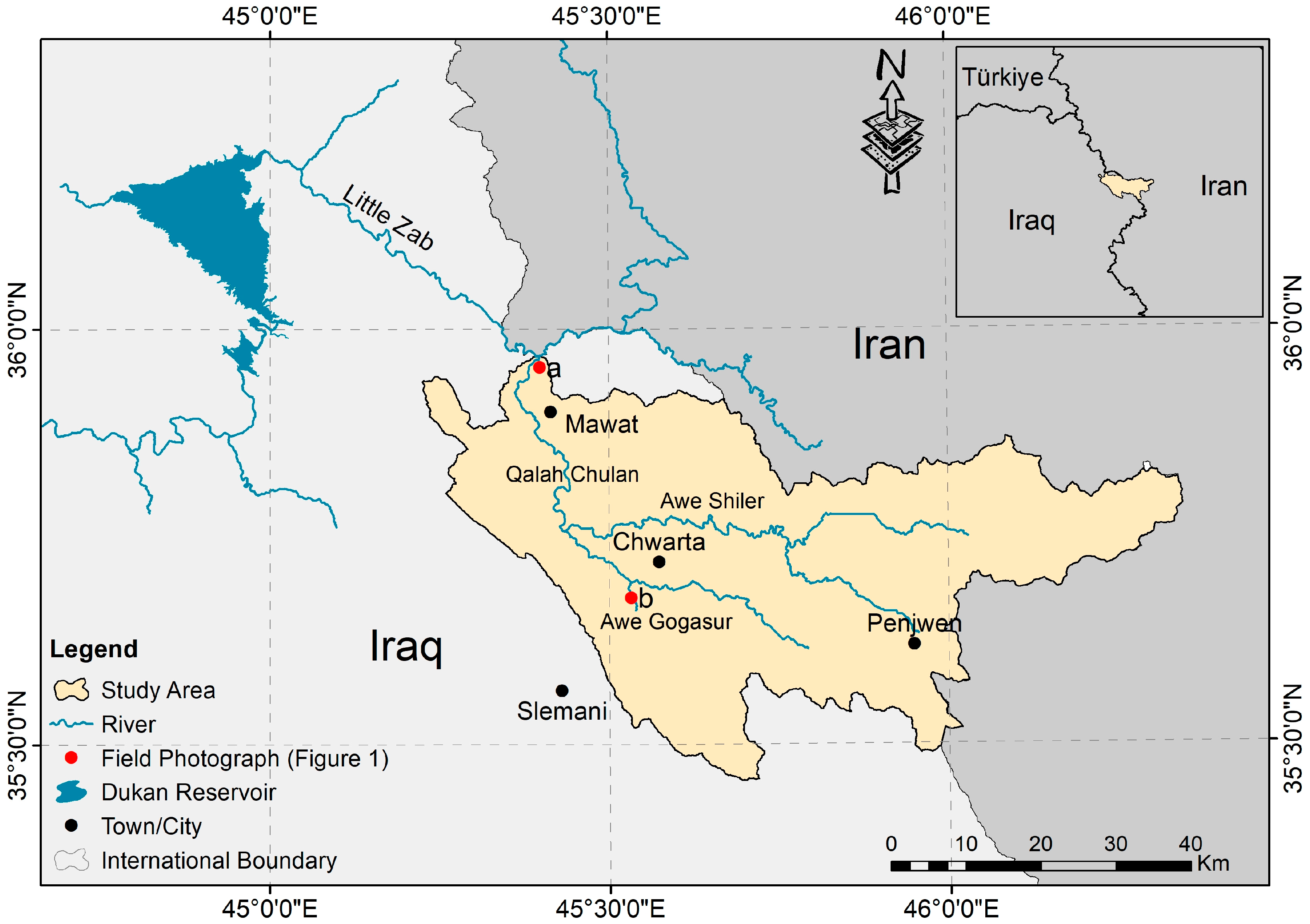
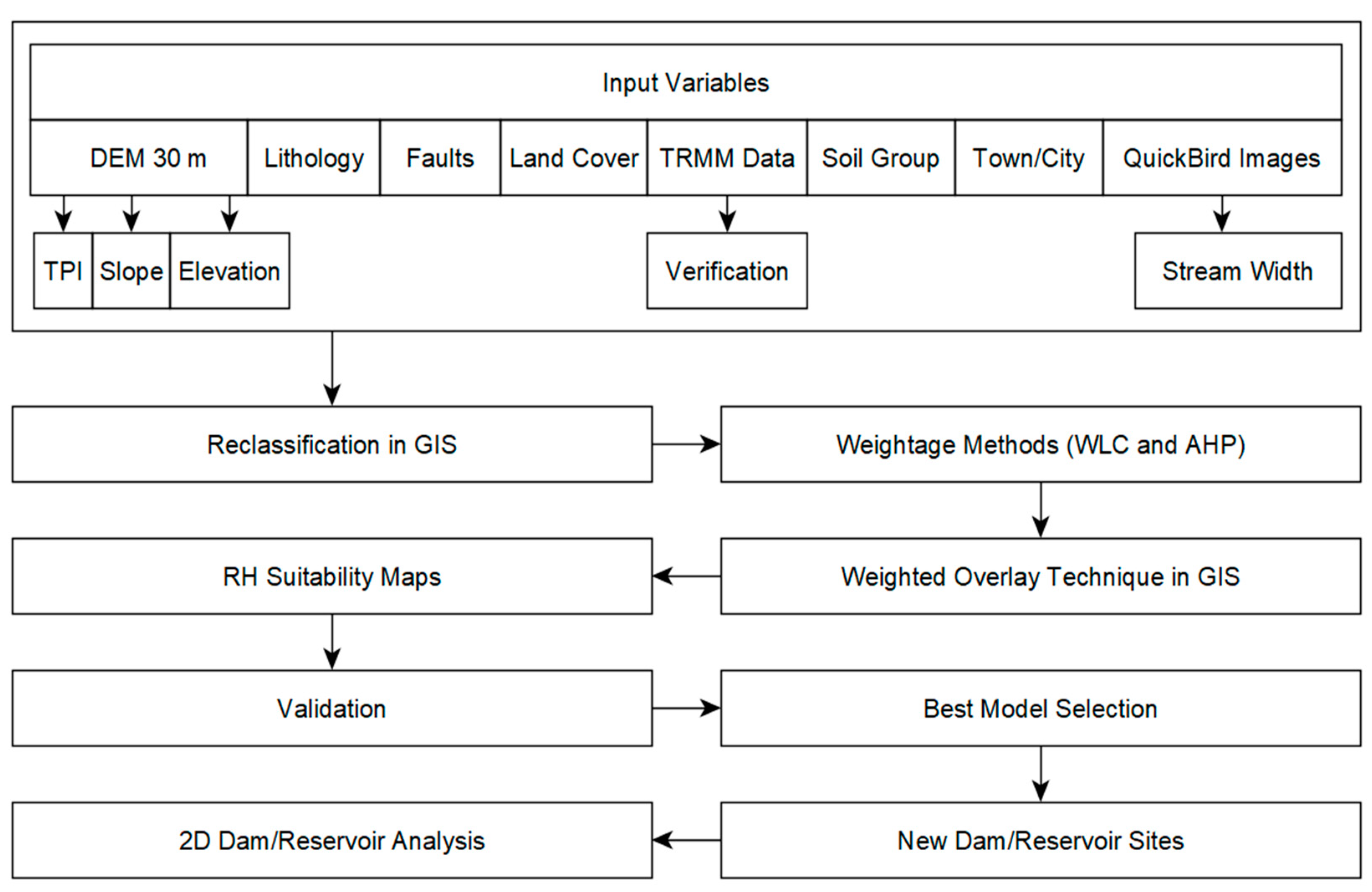
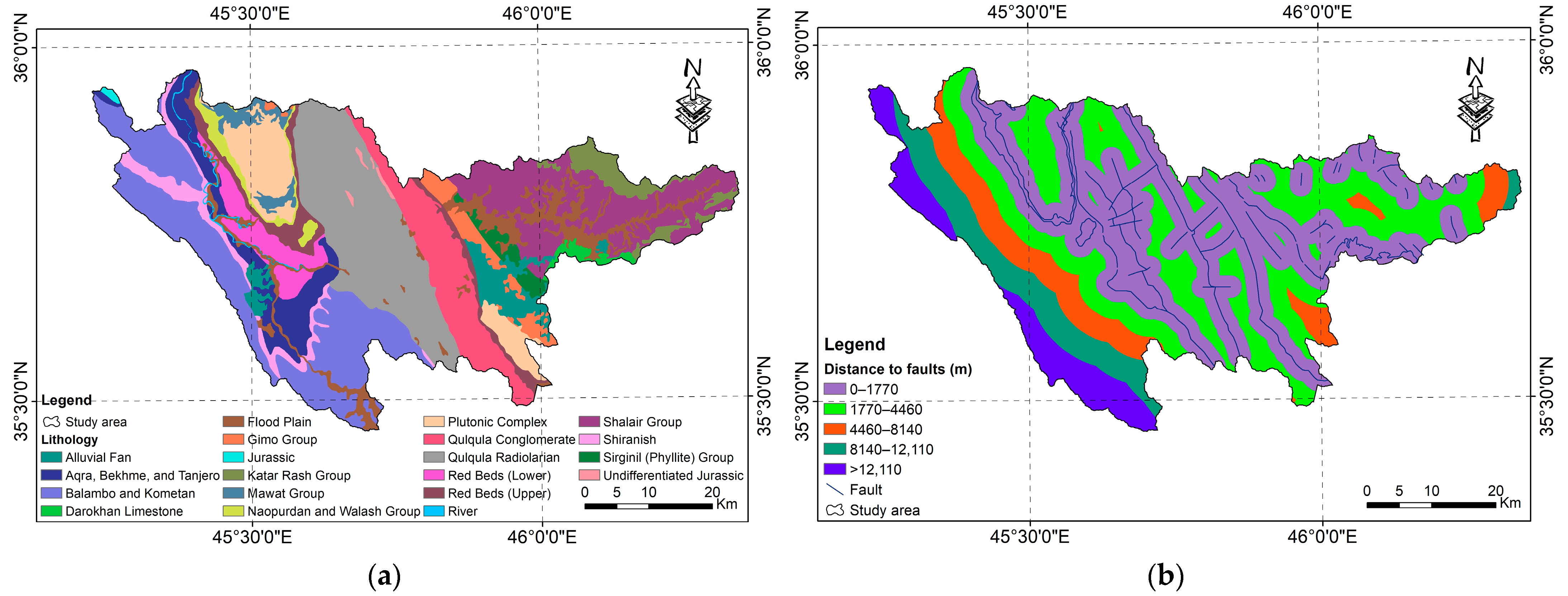
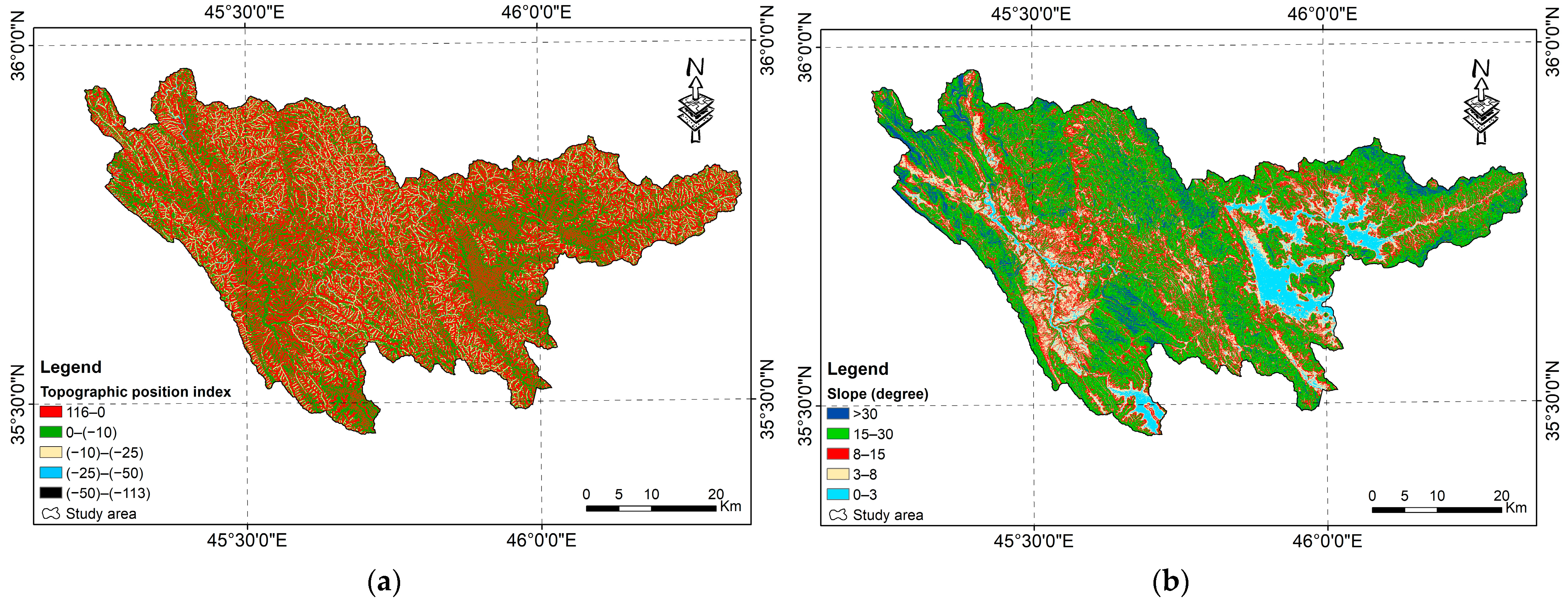
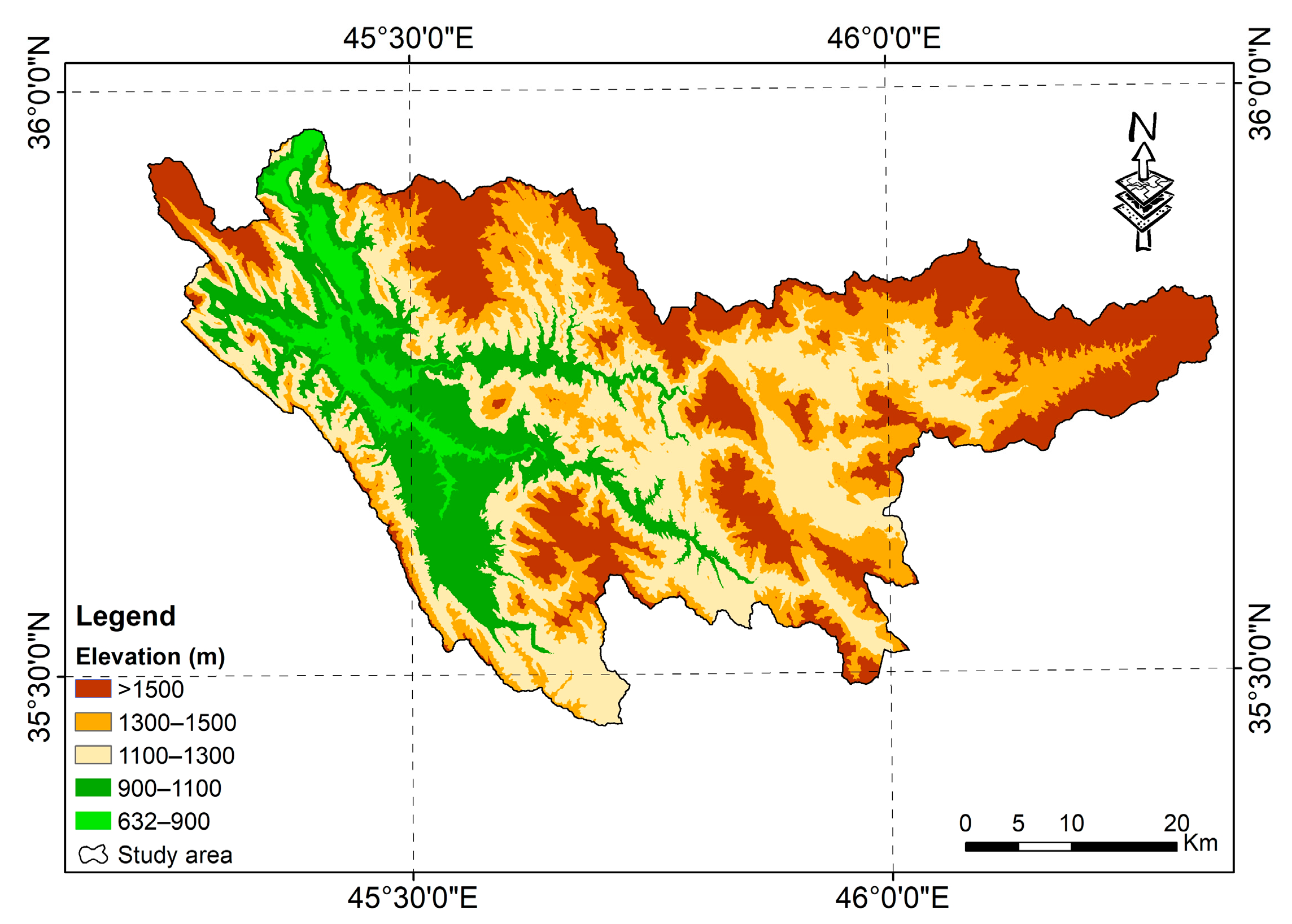
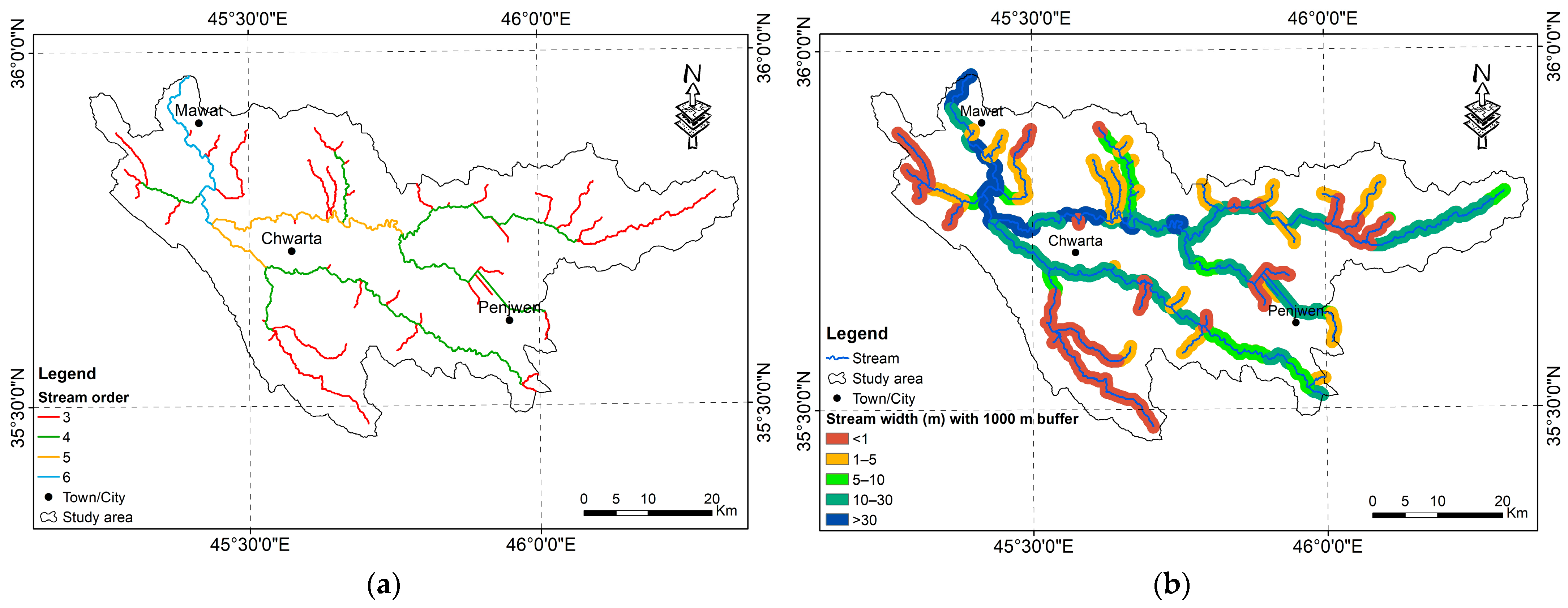
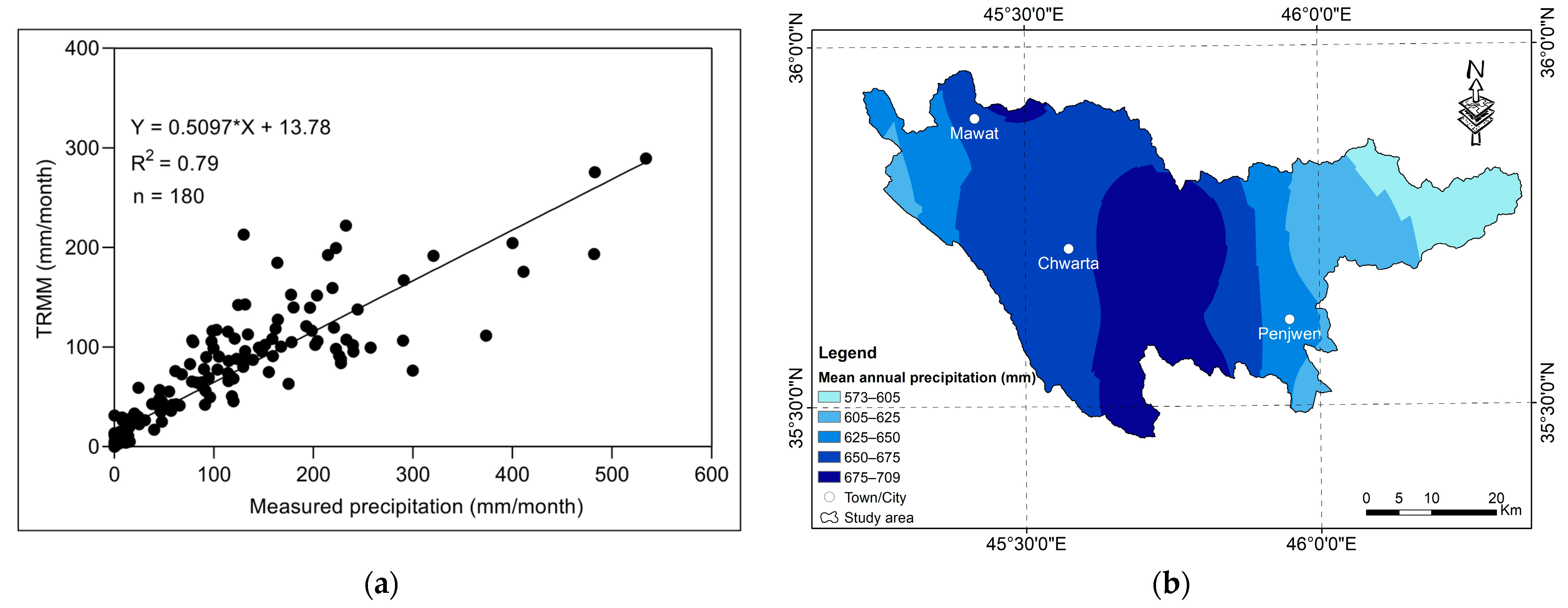

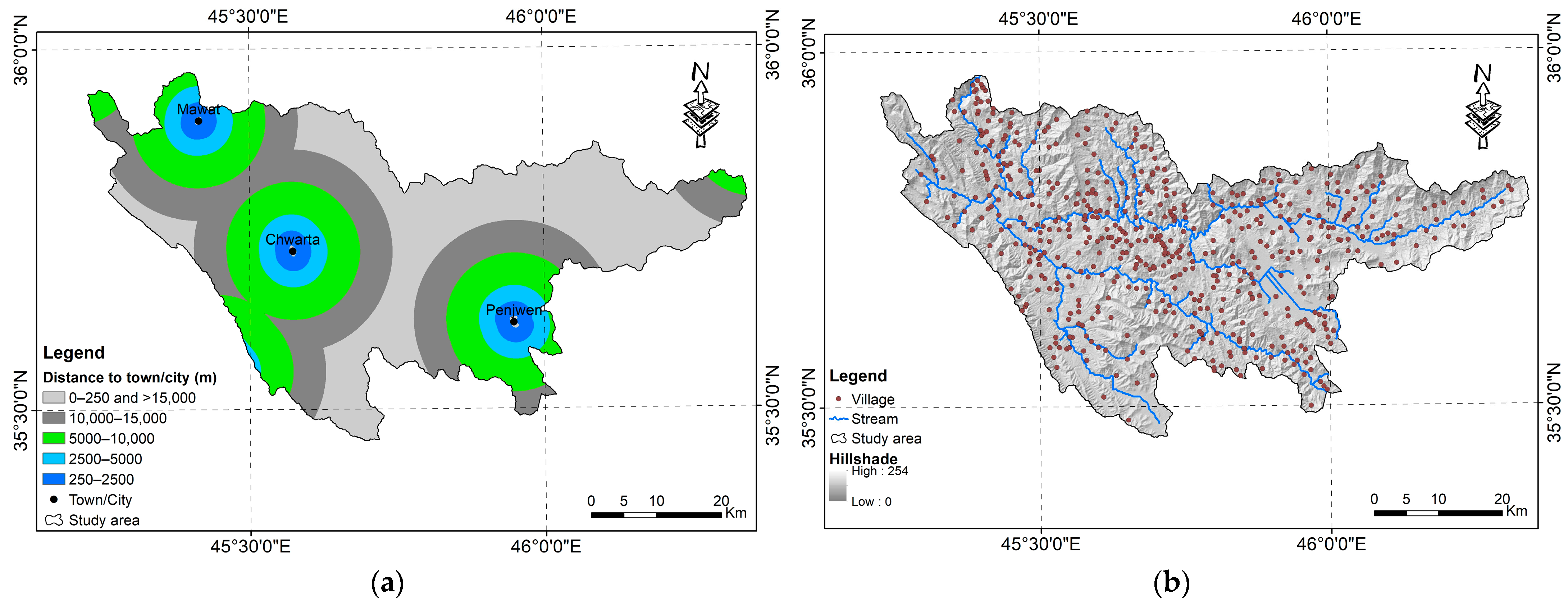
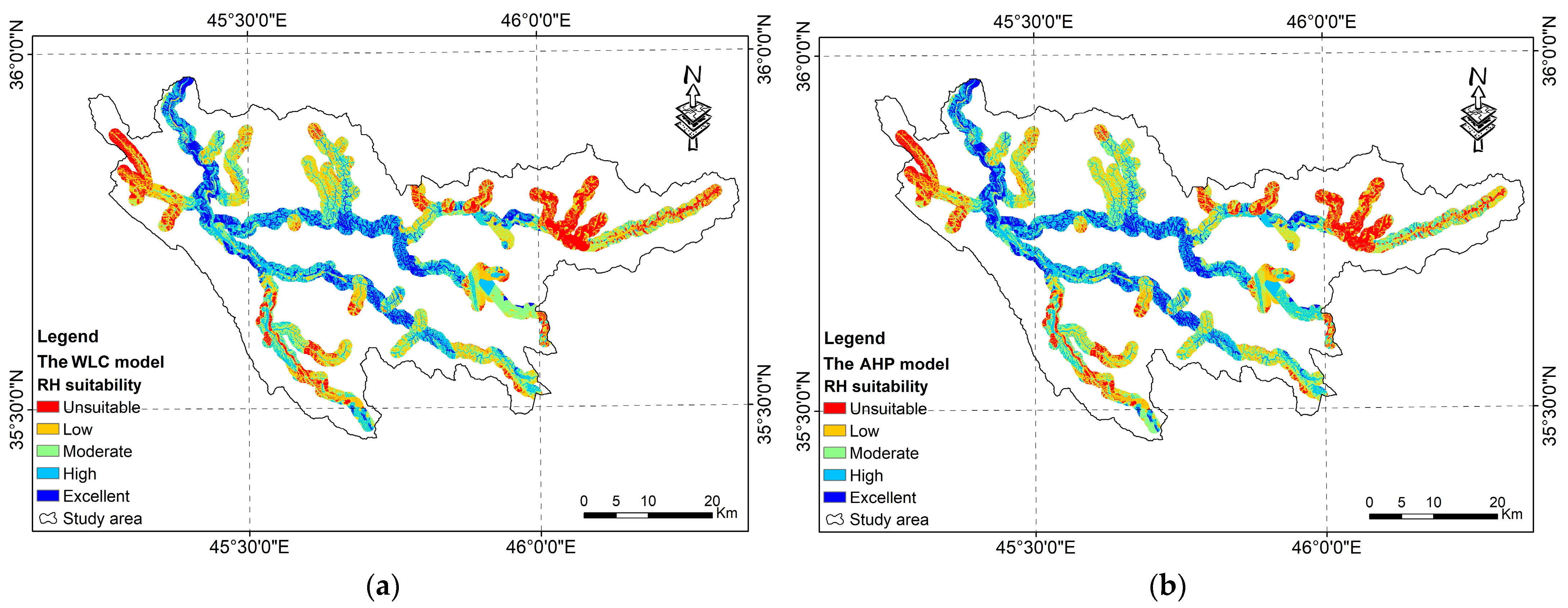
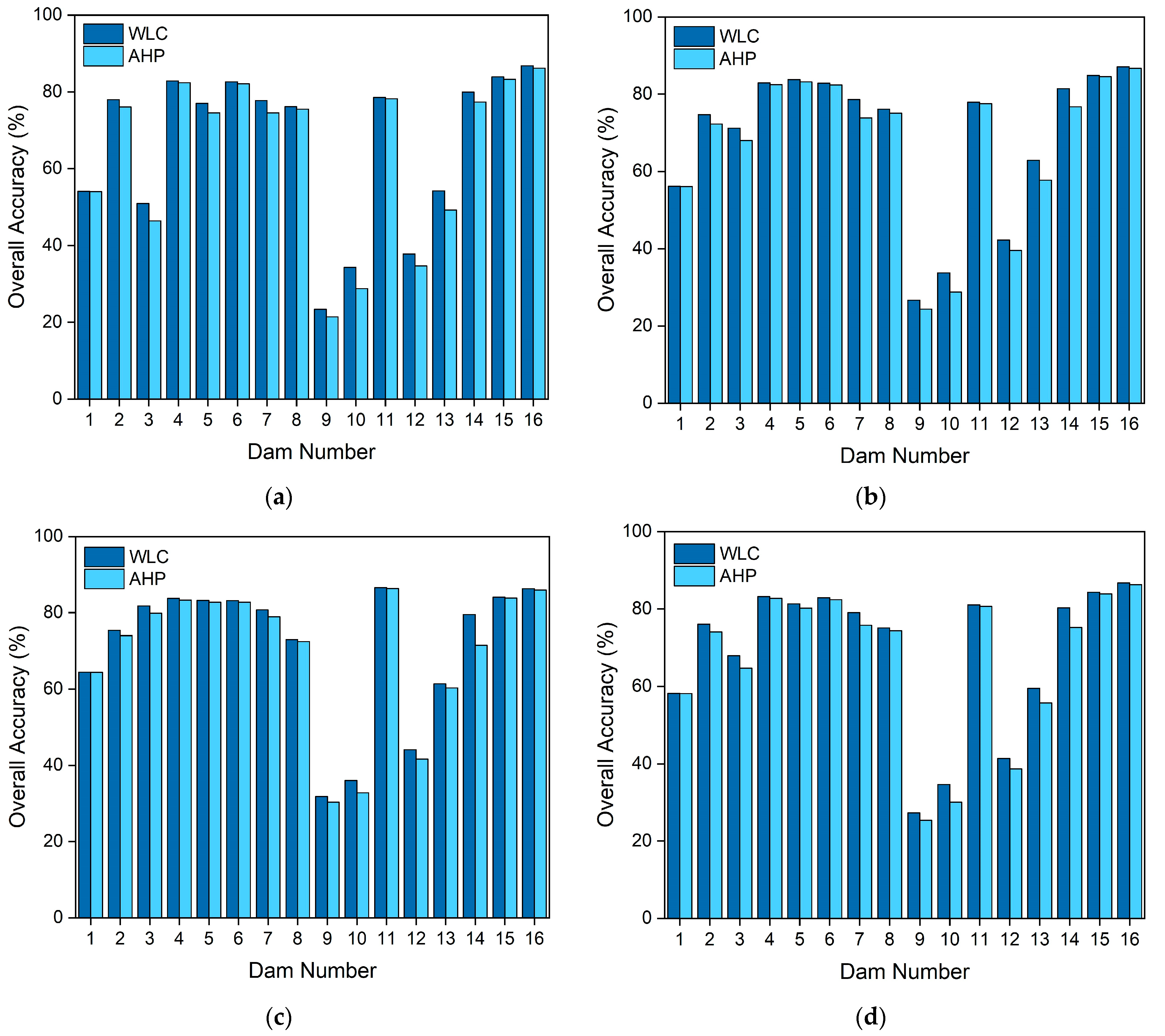
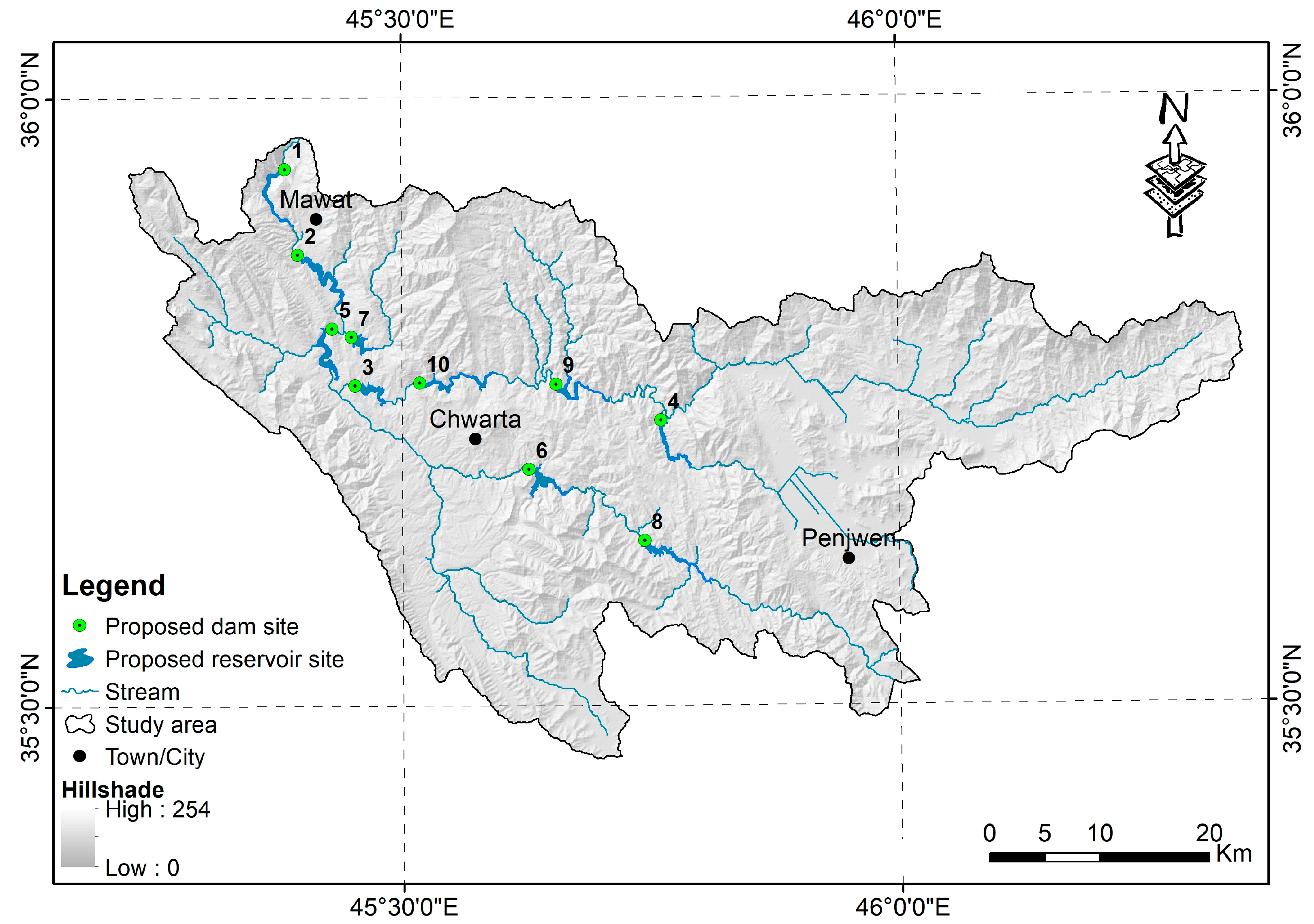
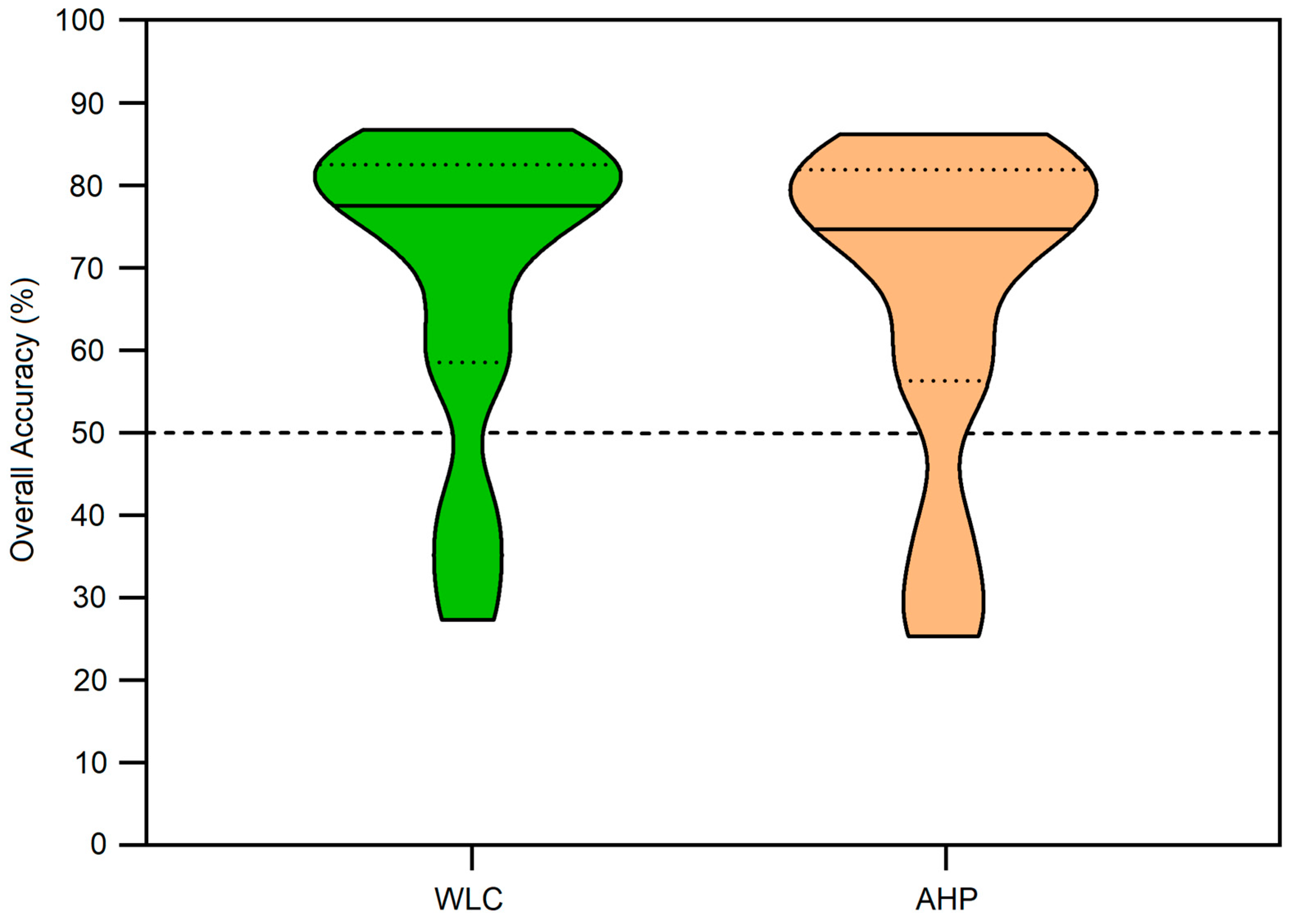
| Reference | Year | Applied Techniques | Country |
|---|---|---|---|
| [47] | 2022 | WLC, RS, and GIS | Australia |
| [48] | 2021 | AHP and GIS | Morocco |
| [49] | 2021 | BO, WLC, and GIS | Iraq |
| [50] | 2017 | AHP, Fuzzy-AHP, ROM, VI, BO, RS, SWAT, and GIS | Iraq |
| [51] | 2021 | WLC, BO, RS, and GIS | Iraq |
| [30] | 2017 | FL, AHP, WLC, and GIS | Iraq |
| [4] | 2020 | AHP, WSM, RS, and GIS | Iraq |
| [2] | 2019 | WLC, AHP, RS, and GIS | Iraq |
| [31] | 2019 | AHP, FL, RS, and GIS | Iraq |
| [52] | 2017 | WLC, BO, and GIS | Jordan |
| [53] | 2016 | AHP, WLC, BO, and GIS | Jordan |
| [54] | 2022 | AHP, WLC, BO, RS, and GIS | Yemen |
| [55] | 2014 | AHP, FIM, BO, WLC, and GIS | Pakistan |
| [33] | 2020 | AHP, RS, and GIS | Pakistan |
| [29] | 2019 | AHP, ML, GIS, and RS | UAE |
| [56] | 2019 | AHP, SSS, and GIS | Iran |
| [57] | 2021 | AHP, WLC, and GIS | Iran |
| [23] | 2018 | AHP, TOPSIS, and GIS | Iran |
| [44] | 2021 | AHP, WLC, SWAT, RS, and GIS | Iran |
| [20] | 2020 | BWM, FL, AHP, WOP, BO, and GIS | Iran |
| [8] | 2022 | AHP, RS, SWAT, RUSLE, and GIS | Rwanda |
| [58] | 2021 | AHP, RS, and GIS | MOZ |
| Rank | Level of Importance |
|---|---|
| 9 | EXI |
| 7 | VSI |
| 5 | SI |
| 3 | MI |
| 1 | EQI |
| 2, 4, 6, 8 | IVS |
| Criterion | TPI | SW | LI | SP | PCP | SG | EL | LC | DF | DTC |
|---|---|---|---|---|---|---|---|---|---|---|
| TPI | 1 | 1 | 2 | 2 | 2 | 2 | 2 | 3 | 9 | 9 |
| SW | 1 | 1 | 2 | 2 | 2 | 2 | 2 | 3 | 9 | 9 |
| LI | 1/2 | 1/2 | 1 | 1 | 2 | 2 | 2 | 2 | 7 | 7 |
| SP | 1/2 | 1/2 | 1 | 1 | 2 | 2 | 2 | 2 | 7 | 7 |
| PCP | 1/2 | 1/2 | 1/2 | 1/2 | 1 | 1 | 1 | 2 | 5 | 5 |
| SG | 1/2 | 1/2 | 1/2 | 1/2 | 1 | 1 | 1 | 2 | 5 | 5 |
| EL | 1/2 | 1/2 | 1/2 | 1/2 | 1 | 1 | 1 | 2 | 5 | 5 |
| LC | 1/3 | 1/3 | 1/2 | 1/2 | 1/2 | 1/2 | 1/2 | 1 | 3 | 3 |
| DF | 1/9 | 1/9 | 1/7 | 1/7 | 1/5 | 1/5 | 1/5 | 1/3 | 1 | 1 |
| DTC | 1/9 | 1/9 | 1/7 | 1/7 | 1/5 | 1/5 | 1/5 | 1/3 | 1 | 1 |
| SUM | 5.06 | 5.06 | 8.28 | 8.28 | 11.9 | 11.9 | 11.9 | 17.7 | 52 | 52 |
| Criterion | TPI | SW | LI | SP | PCP | SG | EL | LC | DF | DTC | Weight | Weight% |
|---|---|---|---|---|---|---|---|---|---|---|---|---|
| TPI | 0.20 | 0.20 | 0.24 | 0.24 | 0.17 | 0.17 | 0.17 | 0.17 | 0.17 | 0.17 | 0.19 | 19 |
| SW | 0.20 | 0.20 | 0.24 | 0.24 | 0.17 | 0.17 | 0.17 | 0.17 | 0.17 | 0.17 | 0.19 | 19 |
| LI | 0.10 | 0.10 | 0.12 | 0.12 | 0.17 | 0.17 | 0.17 | 0.11 | 0.13 | 0.13 | 0.13 | 13 |
| SP | 0.10 | 0.10 | 0.12 | 0.12 | 0.17 | 0.17 | 0.17 | 0.11 | 0.13 | 0.13 | 0.13 | 13 |
| PCP | 0.10 | 0.10 | 0.06 | 0.06 | 0.08 | 0.08 | 0.08 | 0.11 | 0.10 | 0.10 | 0.09 | 9 |
| SG | 0.10 | 0.10 | 0.06 | 0.06 | 0.08 | 0.08 | 0.08 | 0.11 | 0.10 | 0.10 | 0.09 | 9 |
| EL | 0.10 | 0.10 | 0.06 | 0.06 | 0.08 | 0.08 | 0.08 | 0.11 | 0.10 | 0.10 | 0.09 | 9 |
| LC | 0.06 | 0.06 | 0.06 | 0.06 | 0.04 | 0.04 | 0.04 | 0.07 | 0.06 | 0.06 | 0.05 | 5 |
| DF | 0.02 | 0.02 | 0.02 | 0.02 | 0.02 | 0.02 | 0.02 | 0.02 | 0.02 | 0.02 | 0.02 | 2 |
| DTC | 0.02 | 0.02 | 0.02 | 0.02 | 0.02 | 0.02 | 0.02 | 0.02 | 0.02 | 0.02 | 0.02 | 2 |
| SUM | 1 | 1 | 1 | 1 | 1 | 1 | 1 | 1 | 1 | 1 | 1 | 100 |
| n | 1 | 2 | 3 | 4 | 5 | 6 | 7 | 8 | 9 | 10 | 11 | 12 |
| RI | 0 | 0 | 0.52 | 0.89 | 1.11 | 1.25 | 1.35 | 1.40 | 1.45 | 1.49 | 1.52 | 1.54 |
| No. | Lithologic Unit | Suitability | Description |
|---|---|---|---|
| 1 | Flood Plain (FP) | US | Sand, silt, and clay |
| 2 | Alluvial Fan (AF) | US | Gravel, sand, and silt |
| 3 | Red Beds (Upper) (RBU) | MS | Mudstone, conglomerate, sandstone, shale, and siltstone |
| 4 | Red Beds (Lower) (RBL) | MS | Limestone, conglomerate, siltstone, shale, chert, and sandstone |
| 5 | Shiranish (SH) | LS | Argillaceous limestone and marl |
| 6 | Aqra, Bekhme, and Tanjero (ABT) | ES | Limestone, marl, siltstone, sandstone, and conglomerate |
| 7 | Katar Rash Group (KRG) | ES | Andesite, dacite, and rhyolite |
| 8 | Sirginil (Phyllite) Group (SPG) | ES | Metasedimentary rocks and volcanic flows |
| 9 | Qulqula Radiolarian (QR) | ES | Chert and limestone |
| 10 | Qulqula Conglomerate (QC) | MS | Conglomerate, shale, chert, limestone, and breccia |
| 11 | Plutonic Complex (PC) | ES | Gabbro, dunite, and pyroxenite |
| 12 | Gimo Group (GG) | ES | Marble, basalt, schist, phyllite, and amphibolite |
| 13 | Balambo and Kometan (BK) | HS | Limestone, marl, and shale |
| 14 | Shalair Group (SG) | ES | Phyllite, schist, metamorphosed limestones, tuffaceous slate |
| 15 | Mawat Group (MG) | ES | Basalt, greenschist, and amphibolite |
| 16 | Jurassic (JU) | ES | Limestone, dolostone, shale, marl, and breccia |
| 17 | Undifferentiated Jurassic (UJ) | ES | Limestone, dolostone, shale, marl, and breccia |
| 18 | Darokhan Limestone (DL) | ES | Limestone and phyllite |
| 19 | Naopurdan and Walash Group (NWG) | HS | Shale, greywacke, conglomerate, limestone, volcanic sills, mudstone, jasper, siltstone, radiolarite, slate, basalt, andesite, pyroclastic, grit, sandstone, and marl |
| Site No. | Dam | Catchment Area (km2) | Dam Profile (UTM) | Reservoir Area (km2) | Reservoir Volume (m3) | Nv | ||||
|---|---|---|---|---|---|---|---|---|---|---|
| Length (m) | Height (m) | X Start | Y Start | X End | Y End | |||||
| 1 | 924 | 247 | 2996 | 534,146 | 397,774 | 534,947 | 397,728 | 1.82 | 84,990,488 | 0 |
| 2 | 420 | 131 | 2946 | 535,451 | 396,957 | 535,782 | 396,982 | 3.09 | 64,985,592 | 1 |
| 3 | 625 | 95 | 1543 | 541,015 | 395,760 | 540,768 | 395,817 | 1.77 | 25,636,552 | 1 |
| 4 | 515 | 60 | 510 | 568,630 | 395,459 | 569,032 | 395,491 | 1.76 | 49,195,354 | 0 |
| 5 | 835 | 210 | 2774 | 538,805 | 396,345 | 538,869 | 396,262 | 2.60 | 33,801,950 | 3 |
| 6 | 523 | 88 | 501 | 556,669 | 395,002 | 556,906 | 395,048 | 2.49 | 100,715,685 | 1 |
| 7 | 886 | 88 | 113 | 540,424 | 396,190 | 540,801 | 396,271 | 1.49 | 45,342,722 | 2 |
| 8 | 419 | 60 | 369 | 567,130 | 394,365 | 567,492 | 394,386 | 2.41 | 55,517,400 | 1 |
| 9 | 776 | 98 | 1359 | 558,966 | 395,778 | 559,567 | 395,827 | 1.76 | 45,234,931 | 1 |
| 10 | 502 | 141 | 1518 | 546,870 | 395,786 | 546,747 | 395,835 | 2.25 | 102,752,086 | 3 |
| Dam No. | Coordinates | Buffer 1000 m | Buffer 500 m | Buffer 250 m | |||||||
|---|---|---|---|---|---|---|---|---|---|---|---|
| Latitude | Longitude | APn | APw | OA | APn | APw | OA | APn | APw | OA | |
| 1 | 35.9417473 | 45.38232216 | 90.77 | 63.28 | 77.02 | 90.95 | 62.60 | 76.77 | 90.83 | 60.28 | 75.55 |
| 2 | 35.87125439 | 45.3951251 | 94.64 | 66.50 | 80.57 | 96.68 | 69.51 | 83.09 | 94.04 | 72.34 | 83.19 |
| 3 | 35.76361479 | 45.4526547 | 88.36 | 65.50 | 76.93 | 81.44 | 66.46 | 73.95 | 89.91 | 68.78 | 79.34 |
| 4 | 35.73424375 | 45.76093709 | 100 | 66.50 | 83.25 | 100 | 67.33 | 83.66 | 100 | 68.01 | 84.00 |
| 5 | 35.81049214 | 45.42993321 | 92.11 | 65.45 | 78.78 | 89.00 | 68.03 | 78.52 | 100 | 74.45 | 87.23 |
| 6 | 35.69440519 | 45.62756002 | 91.74 | 61.96 | 76.85 | 82.36 | 58.22 | 70.29 | 75.34 | 56.52 | 65.93 |
| 7 | 35.80365931 | 45.44926382 | 93.41 | 61.89 | 77.65 | 96.79 | 66.74 | 81.77 | 100 | 71.59 | 85.79 |
| 8 | 35.63545387 | 45.74358888 | 86.84 | 62.05 | 74.44 | 88.55 | 62.87 | 75.71 | 80.73 | 62.07 | 71.40 |
| 9 | 35.76429905 | 45.65525126 | 96.44 | 65.33 | 80.89 | 94.62 | 66.25 | 80.43 | 100 | 69.12 | 84.56 |
| 10 | 35.76578605 | 45.51786872 | 97.45 | 62.51 | 79.98 | 100 | 64.87 | 82.43 | 100 | 67.93 | 83.97 |
Disclaimer/Publisher’s Note: The statements, opinions and data contained in all publications are solely those of the individual author(s) and contributor(s) and not of MDPI and/or the editor(s). MDPI and/or the editor(s) disclaim responsibility for any injury to people or property resulting from any ideas, methods, instructions or products referred to in the content. |
© 2023 by the authors. Licensee MDPI, Basel, Switzerland. This article is an open access article distributed under the terms and conditions of the Creative Commons Attribution (CC BY) license (https://creativecommons.org/licenses/by/4.0/).
Share and Cite
Al-Kakey, O.; Othman, A.A.; Al-Mukhtar, M.; Dunger, V. Proposing Optimal Locations for Runoff Harvesting and Water Management Structures in the Hami Qeshan Watershed, Iraq. ISPRS Int. J. Geo-Inf. 2023, 12, 312. https://doi.org/10.3390/ijgi12080312
Al-Kakey O, Othman AA, Al-Mukhtar M, Dunger V. Proposing Optimal Locations for Runoff Harvesting and Water Management Structures in the Hami Qeshan Watershed, Iraq. ISPRS International Journal of Geo-Information. 2023; 12(8):312. https://doi.org/10.3390/ijgi12080312
Chicago/Turabian StyleAl-Kakey, Omeed, Arsalan Ahmed Othman, Mustafa Al-Mukhtar, and Volkmar Dunger. 2023. "Proposing Optimal Locations for Runoff Harvesting and Water Management Structures in the Hami Qeshan Watershed, Iraq" ISPRS International Journal of Geo-Information 12, no. 8: 312. https://doi.org/10.3390/ijgi12080312
APA StyleAl-Kakey, O., Othman, A. A., Al-Mukhtar, M., & Dunger, V. (2023). Proposing Optimal Locations for Runoff Harvesting and Water Management Structures in the Hami Qeshan Watershed, Iraq. ISPRS International Journal of Geo-Information, 12(8), 312. https://doi.org/10.3390/ijgi12080312






